Phase Two or Lesson Two on my Quest to be a Good Balkan Wife
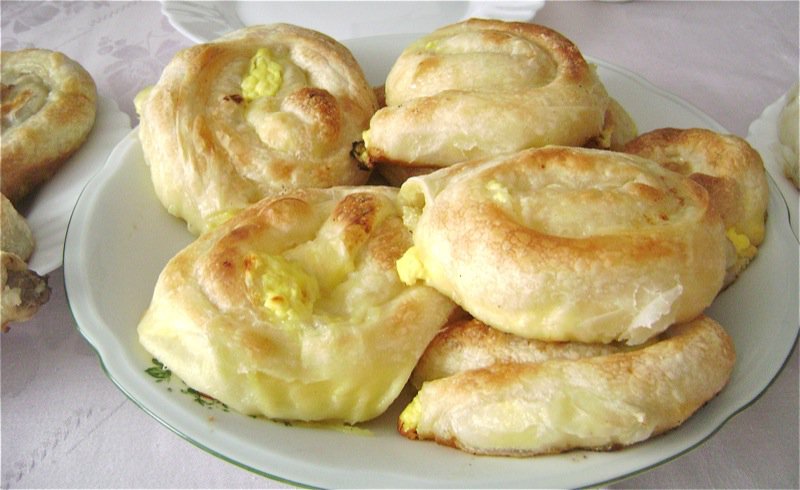 … though impossible as I am seven generations Canadian, but I try!
… though impossible as I am seven generations Canadian, but I try!
Last year was my first lesson of how to make homemade phyllo dough or of how to make burek. It was impossible for me to repeat this learning at home though I had left with such confidence. I couldn’t find flour as fine or as soft to make it with. Then, Amina’s dear friend, Ljerka, told me she uses Sunny Boy brand flour from Planet Organic and that it worked perfectly. By the time I learned this, we were headed back for the summer. I had asked Vanja to arrange another lesson with Elsada so that I could regain my confidence and try again. The morning in Tuzla started bright and early, just how I like it, but not early enough. Ako, Vanja’s dear friend, had already run out to his favourite local neighbourhood butcher and selected the meat for the burek, and had it ground. I was disappointed. I had not told him I wanted to go this time, but I missed it last year, and as soon as I heard a footstep, I was up and out to make sure I didn’t miss this trip. He was already back!
But, Elsada suggested that we also make Sir Pita (Cheese Pie) and I love that, too. It is made with Mladi Sir, a very young cheese (using unpasturised milk) and we are in luck. Every Saturday morning, farmers, or villagers from nearby, pull into a side street near the multitude of high rises in this densely populated area to sell their fresh local wares to the senior tenants who crave their fresh farm food. I don’t know if this is legal. It must be. One finds people almost everywhere in high rise areas throughout the Eastern block, on the streets, selling wares. Ako said that these people come very early and are usually gone and sold out by 9 am. We ran over as we wanted a selection to choose from!
There were just three cars selling today. See them, above, left. They had produce and products in their open trunks and on the ledge beside the sidewalk. None of this milk or cheese in pasteurized. Lovely, old, wisened toothless farmers with smiles that welcomed us immediately. Ako was looking for a firm mladi sir. I was looking for a lighter one. One with a lot of bounce and give. He said the one I picked wasn’t good. (I think it was, but I have learned I still have a lot to learn.) He also bought some smoked cheese. He loves it and wanted me to taste it.
Elsada’s mother makes mladi sir all the time on the farm and she told me how to make it. I cannot wait until I get my hands on some unpasteurized milk. There is nothing in this cheese, but the milk: time and temperature make it as delicious as it is. The cheese is traditionally placed in a colander and you can still see the markings of it on the mladi sir (young cheese) below.
Elsada told Ako that this would be all right for the sir pita (cheese pie) but that it was too firm. A softer, more gelatinous cheese was best. (I thought so… I am learning about the food here!)
Once again, we started. I had brought aprons as gifts for mommy and Emina. Emina had grown so much in one year that her apron hardly fit her. She is a very special child and her grandmother (Elsada’s mother) has worked with her and taught her to make this dough for the traditional meat pie (burek) and cheese pie (sir pita) as it is said in that area:
“When a woman is able to make this dough perfectly, she is ready for marriage.”
Below, Emina models her gift from me and she and her mom have just gifted me with a bošca which is a traditional cloth to cover the table to stretch the burek on. I had told Vanja that nothing we had was working and asked him to ask them to find one for me that would work. Believe me. I had tried to make burek. Oh, I am a Master of Failure. But, I am also a Master of Determination! I was so delighted with my very special gift.
Elsada then shows me the one her grandmother, and Emina’s great grandmother, actually made herself on a loom. This kind of family history and heritage is so precious. Look at that boÅ¡ca below. To think that one’s great grandmother wove the entire cloth and now it is in your home for you to make your burek on and that skill has also been passed down through the family is so tangible and meaningful and incredible.
Emina is setting up the paper and taking charge of the burek making. She is showing her mother and me how much her grandmother has taught her.
Elsada saves the bags her flour comes in to roll the dough out on. It is a great consistency for this purpose.
Everyone needs a paper and a rolling pin (one paper for each piece of dough).
The paper is dusted with flour and the rounds of rested dough are each rolled onto the paper.
Look at little miss go! At this point, I am getting a little concerned. I really need to learn what to do, and Emina is such a good helper she is doing everything for me!
After each round is rolled into this shape and thickness, it is covered with a thin coating of oil that enables the stretching after it rests.
Emina covers the dough with the oil
Elsada is doing the same on her side of the table.
I am smiling proudly as I rolled out my piece and cover it with oil. It is all coming back. But, the flour here is magic to the touch. It reminds me of the flour at Le Cordon Bleu. Why do we have so few choices in Canada?
Below, I am ogling the lovely flat well oiled dough.
While the dough rests, we make the cheese filling with the mladi sir. Ako told me it was the same thing as cottage cheese, but there is nothing like this cheese in out stores. It is very delicate and lovely. Below, it is broken with a fork.
It looks drier than it actually was as it was still a very moist cheese.
Look at those eggs. This is the expectation for eggs here. One has to know who farmed the chickens, where they came from, what they are fed. Buying eggs from a store is happening by the really new generation, but it is clearly understood that the quality of an egg purchased from a mega store is significantly diminished.
Emina loves to cook! She mixed up the cheese filling in no time!
Now, the freshly ground meat purchased from the butcher early in the morning will be made into a filling for the burek.
The ingredients are very simple and straightforward: onion, garlic, sparkling mineral water, salt and pepper and the best beef possible with some flavourful fat.
These are Emina’s cool shades to protect her eyes from crying when we cut the onion.
In goes the sparkling mineral water. You could definitely use soda water, instead.
The meat is fragrant with the finely minced aromatics kneaded together. Emina checks the resting dough for elasticity. Yes, it is time, she says. How she knows, is beyond me. Elsada said it was 15 minutes resting, that is how!
Look at her serious expression. I imagine that is how I look making it, too, but with less confidence. Mom and daughter worked together. It was a beautiful sight, but I interrupted it anyway, “Can I try? I really need to learn!”
I could see I was going to be in the way. They really had it down pat. There were no words between them. They read one another’s mind and just moved from one section to the other pulling the dough out effortlessly, like magic. I was getting antsy. I needed a lot of practice. I remembered this feeling. I think I was in kindergarten when I last had it, waiting at the water fountain!
Look at what they have done in less than 5 minutes. I was sweating. Perspiring? Beading? Flushed?… becoming very, very impatient for MY turn!
Elsada said I could put the meat around the edges. This was the easy part! Well, you still have to be very skimpy with the meat. Look at the quality of that beef. It is actually from a very young cow.
I think this might be a little too much here. Let’s check.
No. It is good. Emina is already using the knife exactly like her mother does to trim the extra length off of the sides of the dough.
The dough is scored down the middle and the burek is rolled form each side into the centre to form two long rolls. But, first, Elsada drips a very careful amount of melted butter on the surface of the dough.
See how beautiful and thin this dough is?
The draping edges are folded up over the meat and the melted butter is sprinkled onto the dough.
Now, the cloth is lifted on each side to enable the meat inside of the dough to roll over onto itself and form a roll. See how Elsada is doing it, below, right?
The very ends of the dough are covered. each rope makes about three burek, or six from the entire batch.
Elsada was so excited about the lovely texture of her pastry or dough. She showed me the air bubbles in the dough which you can see, below.
Later, she was able to show me dough that was not nice as it had clumped when it was being stretched. You can see this below. I would be thrilled with this clumpy dough. You would never know eating it… but, you would see it, I guess, on the outer layer, when baked.
After the pan is full, she again is very careful to use the melted butter sparingly.
In they go to the oven she has preheated (all specifics are posted below with the recipe). Look at me! I ripped the beautiful dough! Elsada taught me how to fix it, but I think I would have figured that out… no one will know, but I can tell even though no one will ever know, if she did it, it would really bother her. A perfectionist is a perfectionist, and I have to admit that when I know how to do something well, if drives me bananas when I make a mistake. It is about no one else, only about me and my own ability and my personal goal to succeed.
This looks like scrambled eggs, but it is young cheese with eggs and salt and pepper. The gorgeous yolks colour the cheese a really bright yellow to the egg yolk colour standard urban Canadians are used to.
This is just milk with nothing added made into this beautiful young unpasteurized cheese with gorgeous farm eggs and salt and pepper. How good for you is that?
The process is exactly the same all over again: cut off the sides of the pastry (belowt)so there is no thickness there to be rolled into the pita (above, left).
And, roll the pastry onto the filling by using the cloth it is sitting on, then continue by hand.
The butter is sparingly sprinkled on the pastry, and then it is rolled, cut and placed into a well oiled pan for baking, too.
The burek is ready to come out as the sir pita is ready to go in!
As soon as it is out of the oven, Elsada pours sparkling water over the burek sparingly to soften the dough and then pops it back into the oven for a few more minutes. The last beautiful sheer pastry will finish up the meat and the cheese fillings.
Doesn’t this look delectable? It does to me as I know how it tastes. I love that this layered lovely paper thin flaky pastry is not laden with butter. Don’t get me wrong. I love heavily buttered phyllo, too, but this is such a welcome alternative and a much healthier version.
At this point, Elsada explained that the woman always wears a marama when making burek. It is the old fashioned scarf you see on TV when some of the village women are wearing their traditional garb. Then she went on to explain that she and Emina wear these caps to keep their hair out of the burek and the pita. I was thrilled! It drives me crazy to find a little hair in anything and I am vehement in my classroom about my students having their hair up and off of their face securely. Brilliant idea! What fun! Look at me! We definitely had a few giggles here.
The burek is resting under the tea towel staying hot for our breakfast while Elsada butters the last batch.
YUM. In they go and time to tidy up and to set the table.
This is a tradtional treat: burek.
And, accompanying the burek, another very special traditional treat: sir pita.
Where is Vanja? He was out visiting a friend, and we are all waiting. The meal is getting cold and the aroma is intoxicating. We must eat. Look at Mirza giving his dad (Ako) “the eye” for being so silly. Is this role reversal, Ako?
Never mind. I must begin. Cheese pita is my favourite. Yum!
Oh, here is the tardy guest! He said he could smell it from the parking lot. He was lucky he arrived in the nick of time! Burek is his favourite.
After the meal, we had a lot of dough left from all of the bits hanging over the table that were cut off of each pastry laden with filling. Elsada had them rolled into another dough ball, rolled, and resting while we ate. Now we make yet another traditional treat: maslenica! This is the pastry with nothing in it. Apparently they love to eat it as a treat with kajmak (impossible to describe unless you have had it, but it is a very sour milk cheese-like food) and pavlaka (similar to sour cream). Look at the gorgeous thin dough. Yes, there are some thicker bits as this is made with the left over pieces. It will probably not have the beautiful air bubbles in it, but it will be a beautiful treat.
We work to stretch it over the table…. there we go.
Elsada then sprinkled it with butter and folded one third of the pastry over on top of itself.
She folded the other one third back on top of the folded portion to have three layers of pastry in the middle of the table: a little more butter.
Again, the pastry gets folded into three.
And then into three again, or in half; whatever it takes to fit into the baking dish at this point.
There it is before and after baking (below), but the after has already been tested. I wasn’t fast enough with my camera!
I was astounded by the flakiness of this pastry. I didn’t care for it too much on its own. It was definitely tasty, but there is no comparison with this to the filled pitas. I could not imagine going to the trouble of making this incredible ultra thin pastry and then leaving it without a filling. It was hard for me to understand. However, it is a cultural treat, and that I do understand. I would fill it with grated apples and cinnamon and sugar which is another traditional pita in this region, and another of Vanja’s favourites, as well!
Once again, with warmth and love and such appreciation: thank you Elsada and Emina for sharing this family tradition with me. I will work hard this year so I can make it for you next summer. I really will try!
Pastry Recipe (for Burek and Sir Pita)
Yield: 12 burek or sir pita (two rounds of dough)
Ingredients:
- 1 kilo flour
- 2 teaspoons salt
- 340g (400ml) water
- 1/4 cup melted unsalted butter
- 1 tablespoon oil
Instructions:
- Mix all ingredients together, and knead until dough is soft, but not sticky (about 5 minutes, once experienced – see pictures in both posts)
- Cover with plastic wrap and a tea towel and rest for thirty minutes
- Divide into two portions and make each into a ball (each will make 6 burek or 6 sir pita)
- Preheat oven to 500° F
- Roll each ball on a flour dusted sturdy paper, turning only once, until about 1/4 inch thick
- Spread oil over the surface of each rolled pastry oval very lightly, but cover the entire surface area to enable easy stretching later
- Rest for 15 minutes (and not more than 5 minutes longer) and prepare the meat (mince the onion and mix all ingredients together)
- Transfer one disc of pastry dough to the middle of the table covered with a boÅ¡ca (“œburek” cloth); using hands gently from the middle of the pastry to stretch it and lay it out
- Then, pull the dough out little by little around the table and around again until it covers the table and then pull it to just go over the edge of the table; use your fingers in a pinching motion very lightly
- Take half of the meat portion and lay it out on the edge of the table little by little until there is some meat all around the circumference of the table
- Add the oil to the melted butter and sprinkle just a little over the pastry on each portion (make a circle with the sprinkling)
- Cut the dough in half down the middle of the table; and cut off the thickened edge of the dough from the overhanging portion
- Flip the overhanging pastry from the side of the table to over the meat laid out on the table until all is covered
- Then, lift the cloth gently to force the dough to gently roll toward the centre of the table; stop it when you can easily roll the rest by hand
- Use the butter and oil to grease the baking pan; roll each end of the two ropes of dough into two burek portions and leave enough in the middle for a third
- Place all in the pan and very lightly brush with butter oil mixture
- Bake for 10 to 12 minutes at 500 and remove from the oven
- Pour about 1/2 cup of sparkling mineral water over the golden burek and return to the oven for 5 more minutes
- Take out of the oven and cover with a tea towel for at least five minutes before serving
- Serve with yogurt to drink
Burek Recipe
Yield: 12 burek
- one pastry recipe (above)
- 1 kilo freshly ground beef
- 1 teaspoon salt
- 1/4 teaspoon pepper
- 60 mls sparkling mineral water (or soda water)
- 1/4 large or 1/2 medium onion, minced
Mix all ingredients together
Sir Pita Recipe
Yield: 12 sir pita
- one pastry recipe (above)
- 1 kilo mladi sir (fresh young cheese as pictured and described above)
- 1 teaspoon salt
- 1/4 teaspoon pepper
- 2 farm fresh eggs
Mix all ingredients together
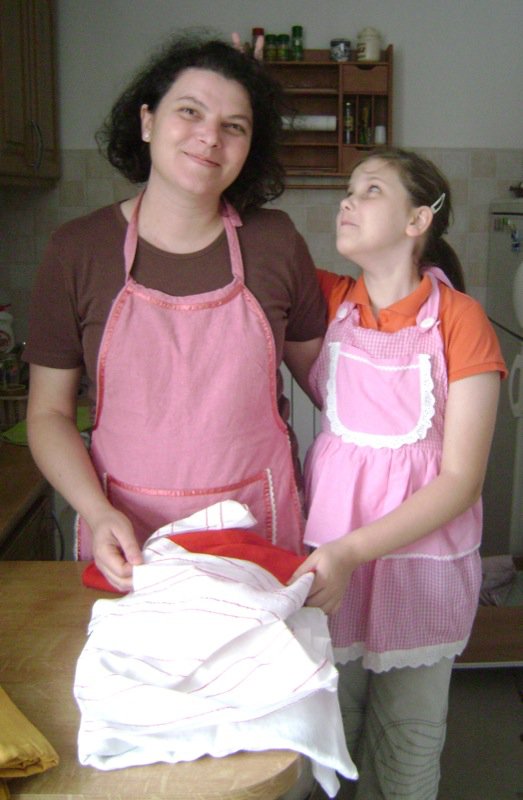
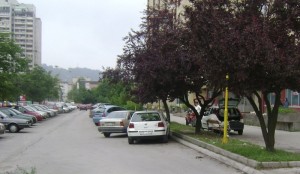
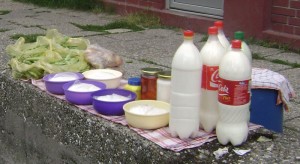
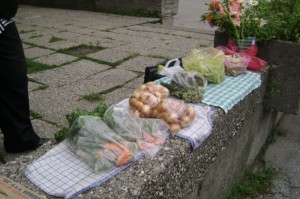
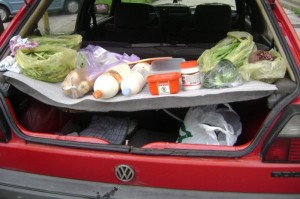
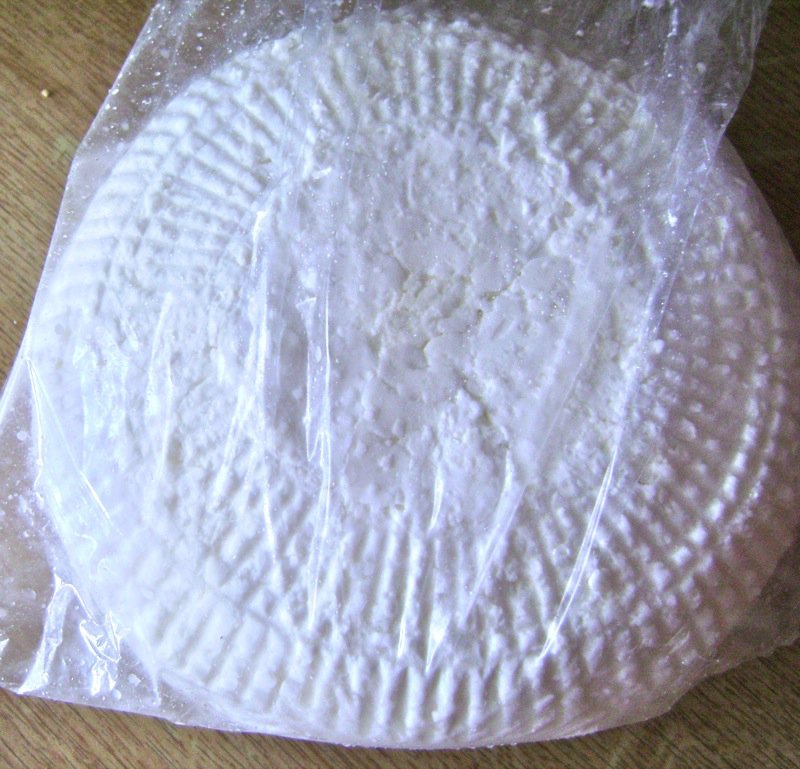
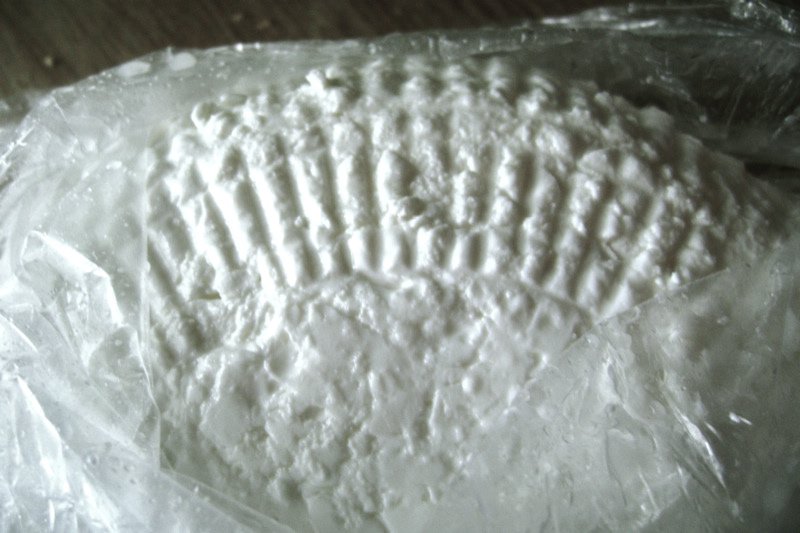
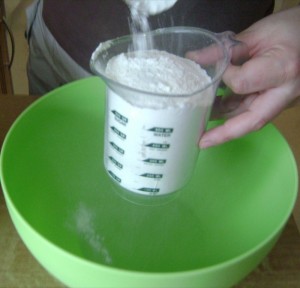
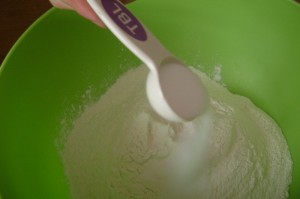
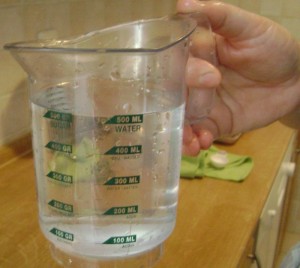
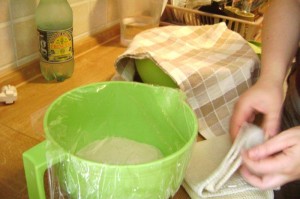
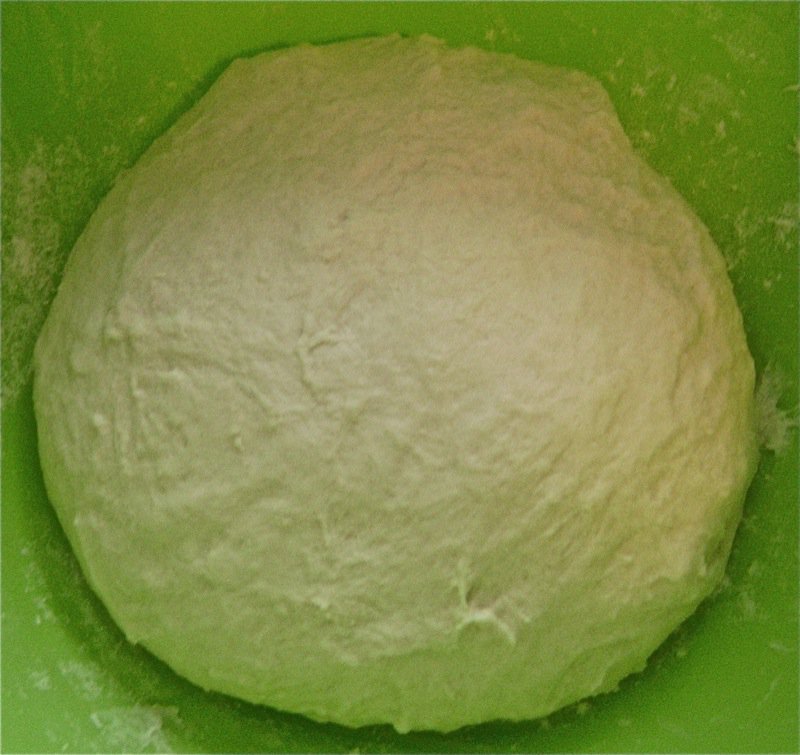
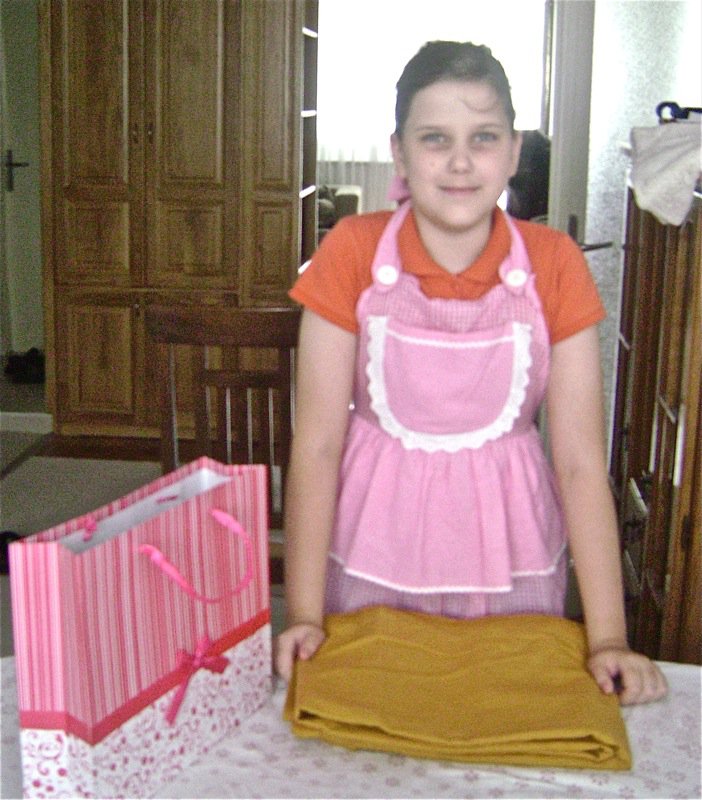
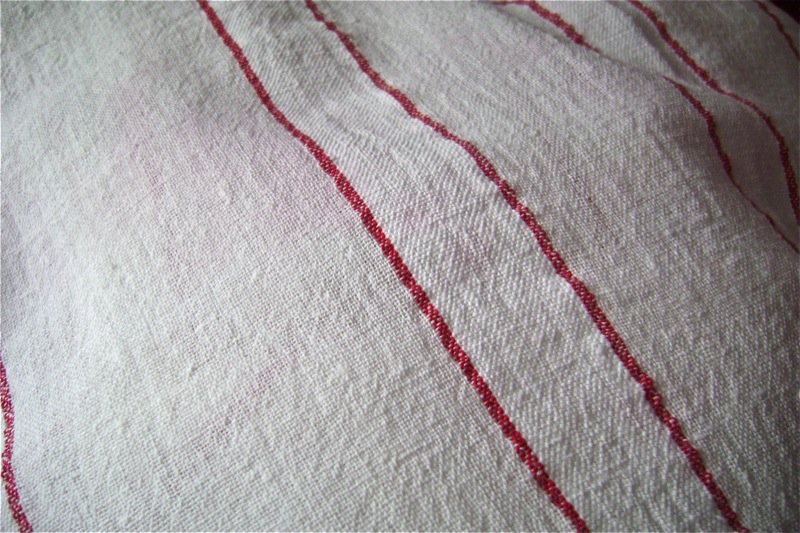
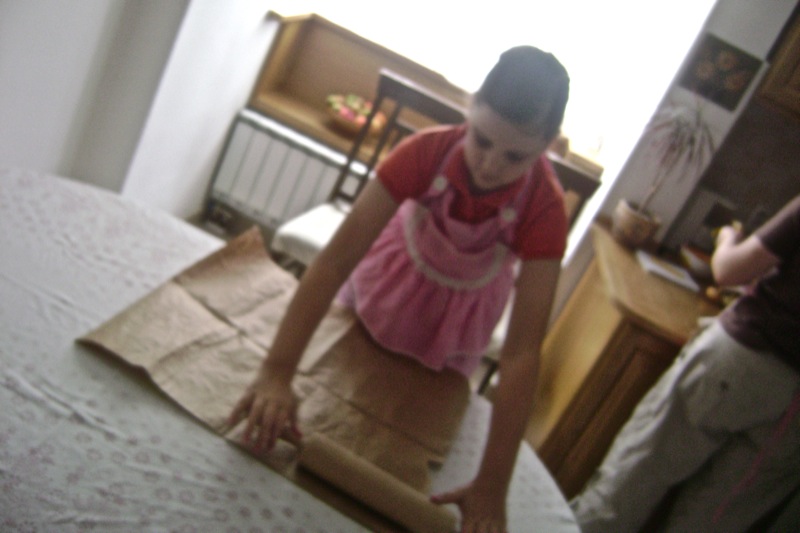
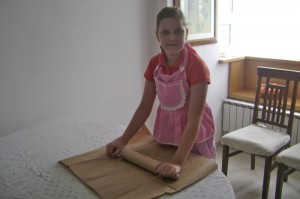
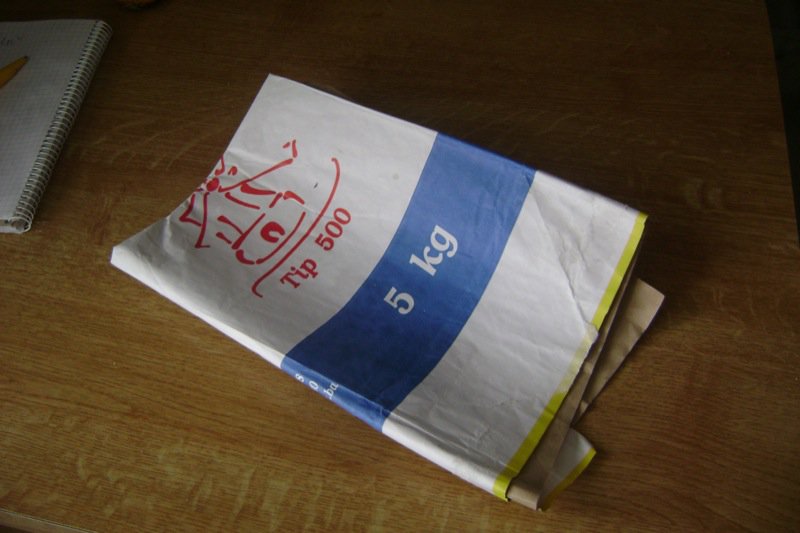
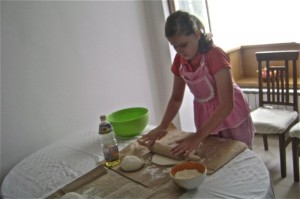
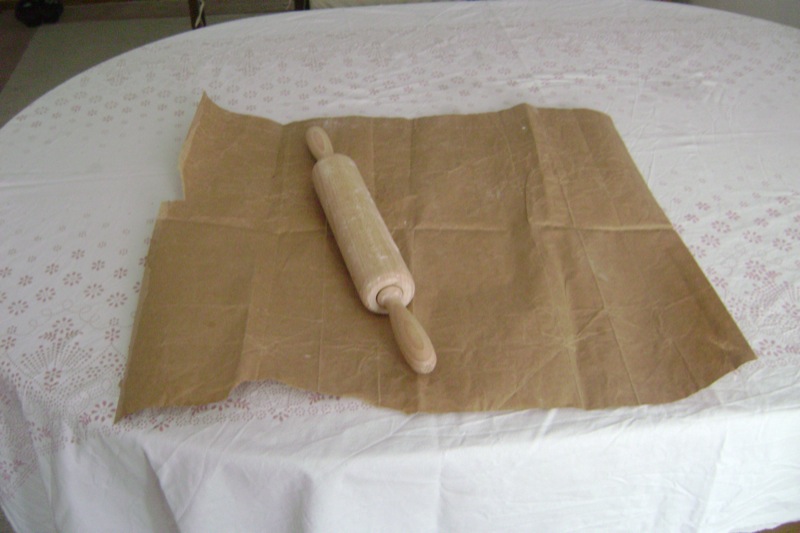
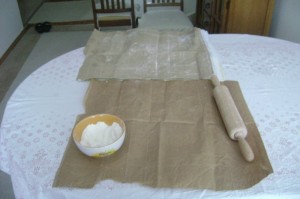
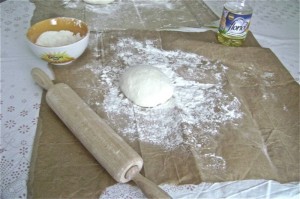
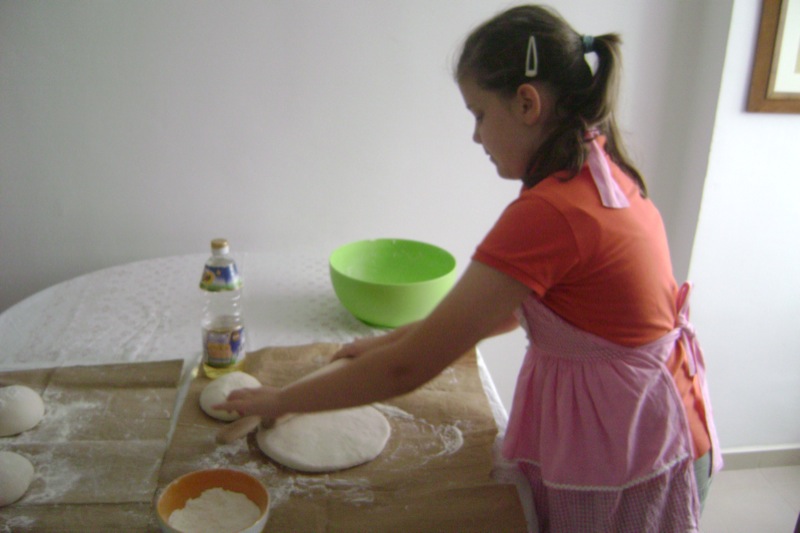
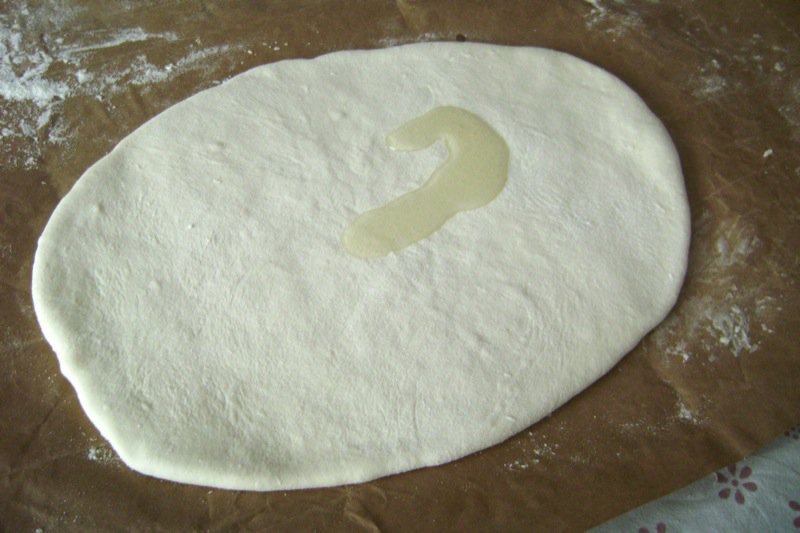
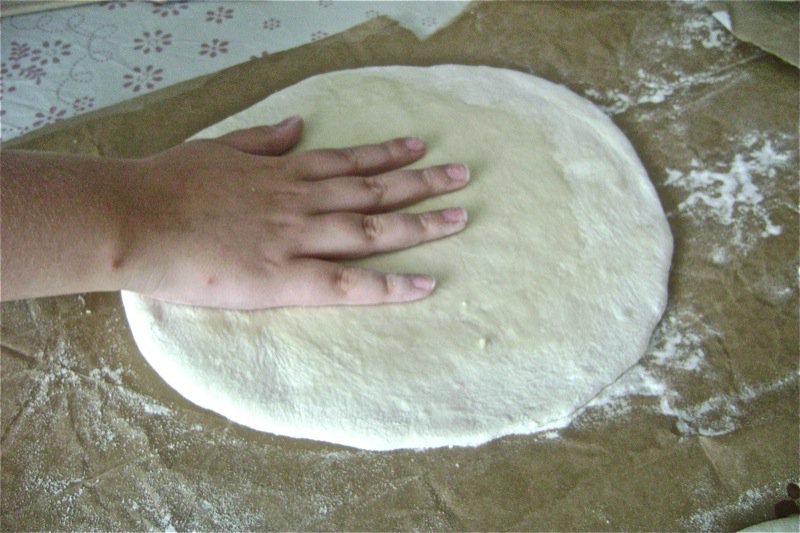
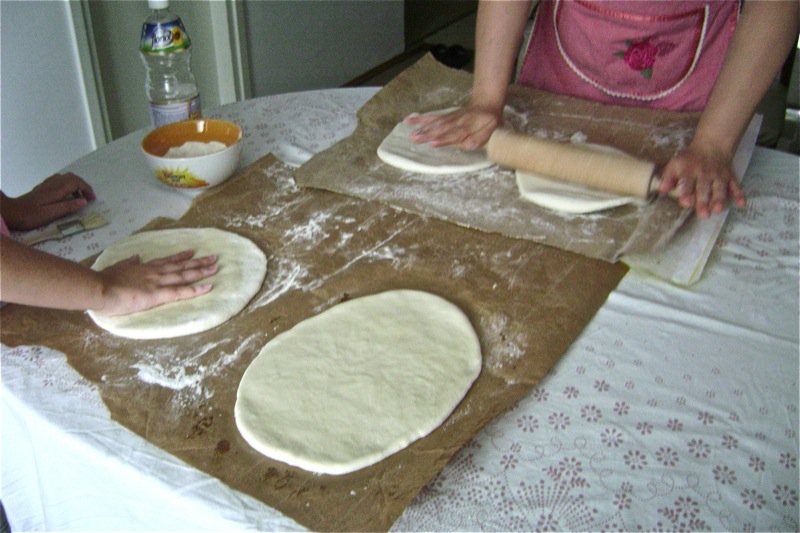
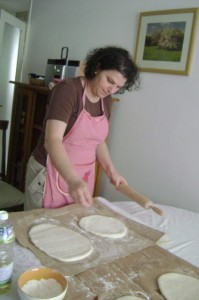
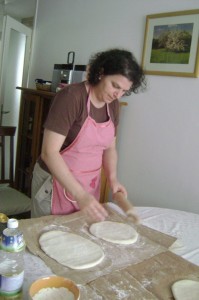
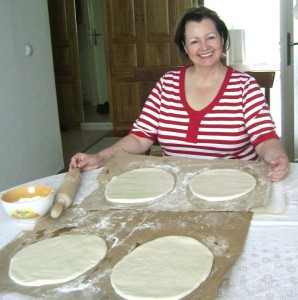
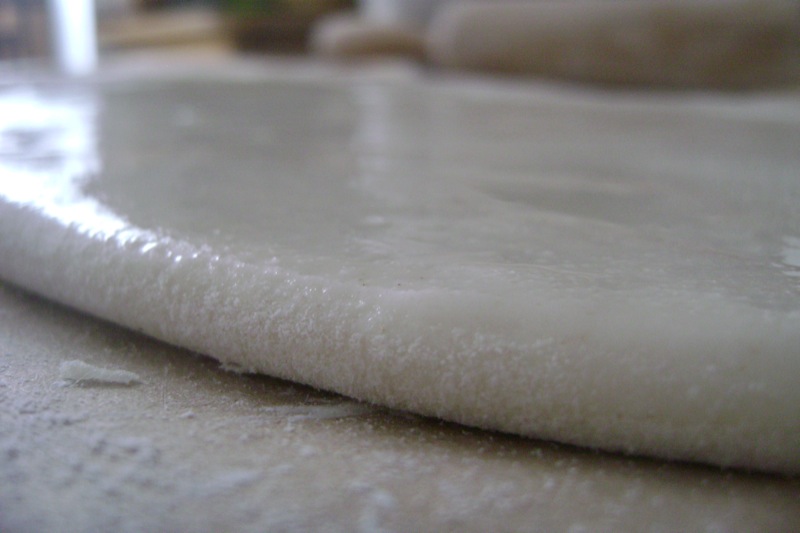
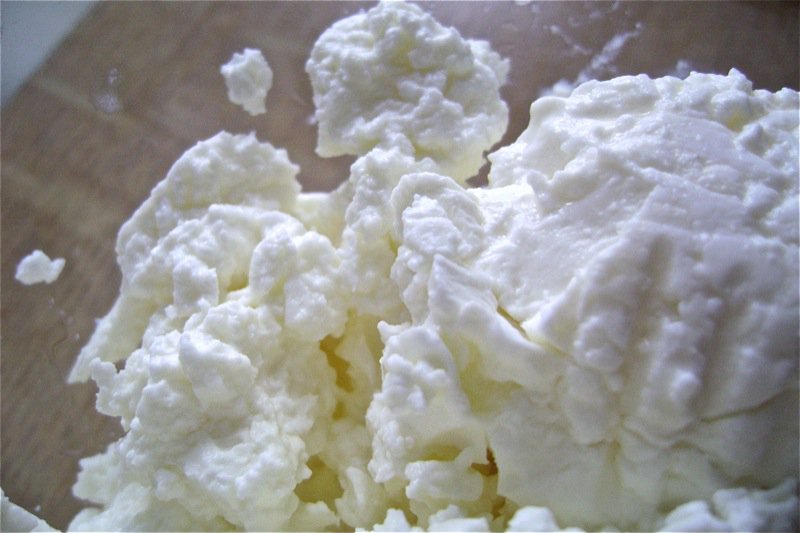
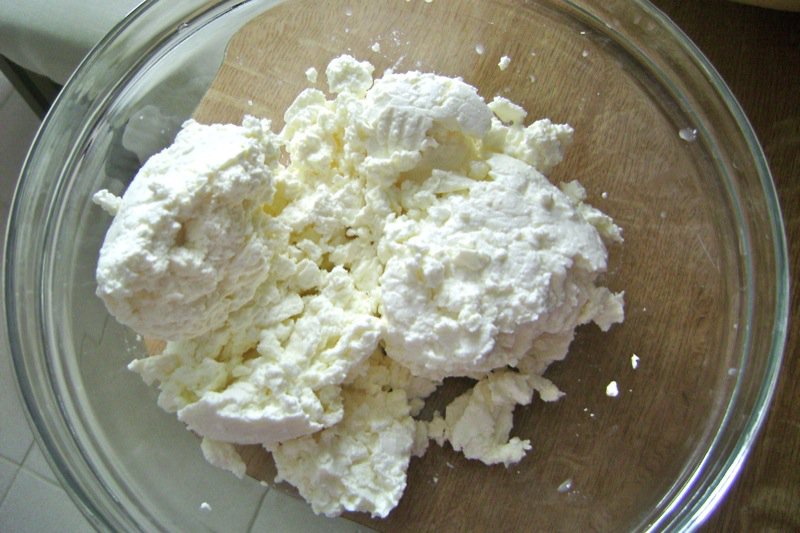
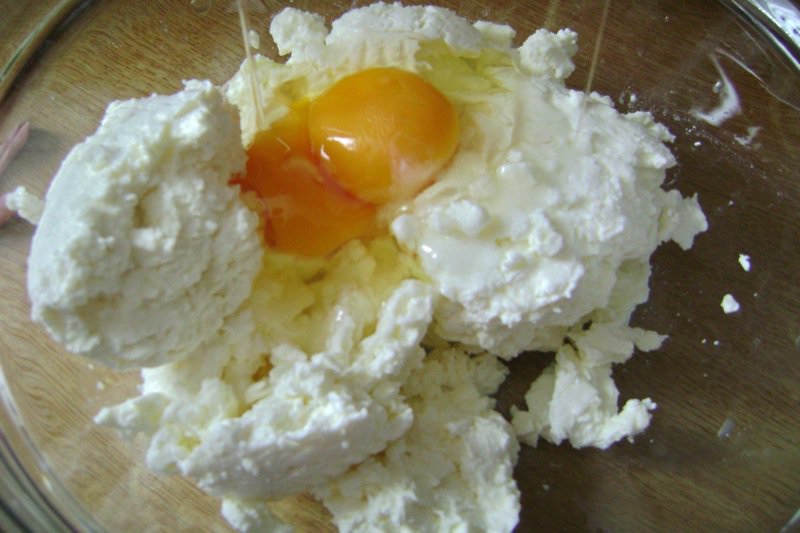
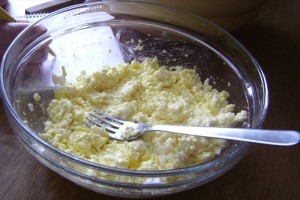
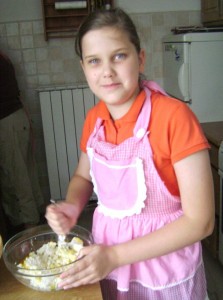
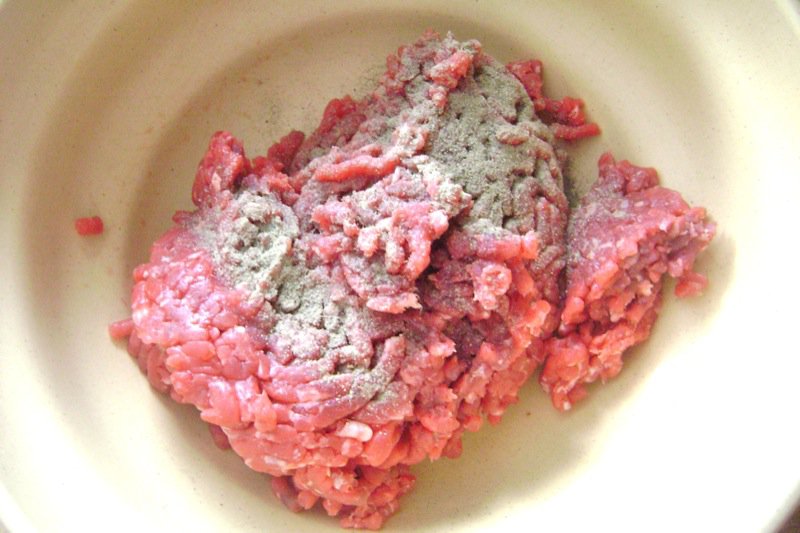
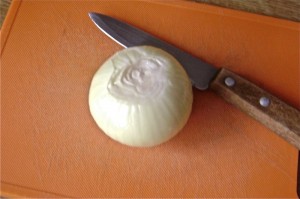
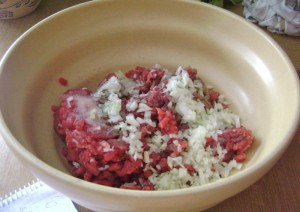
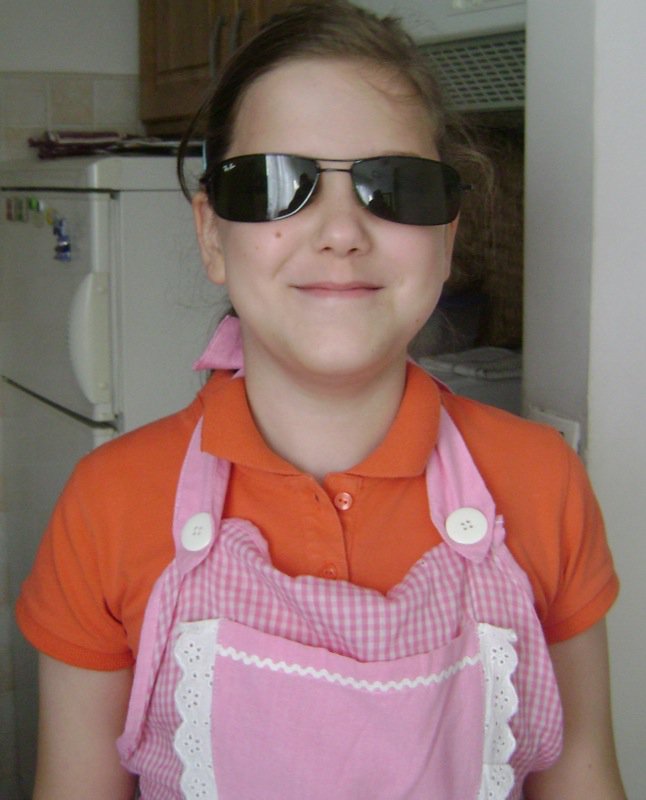
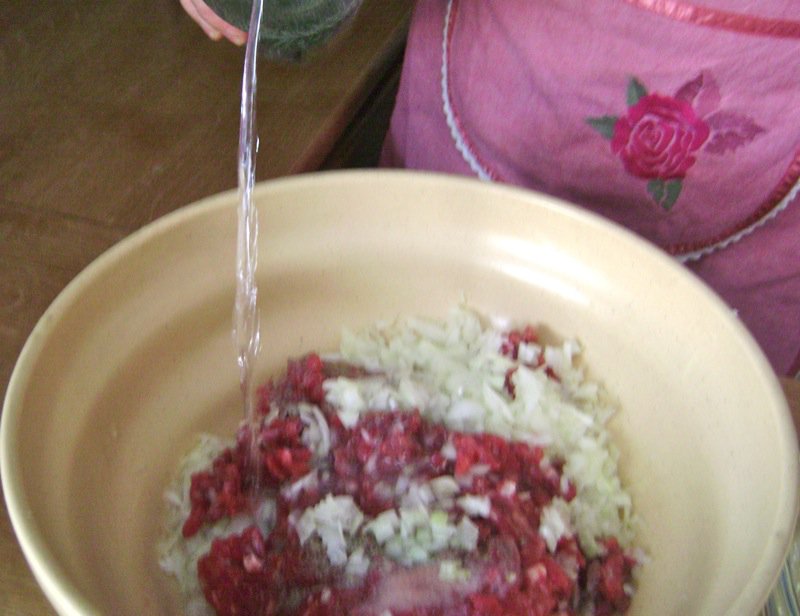
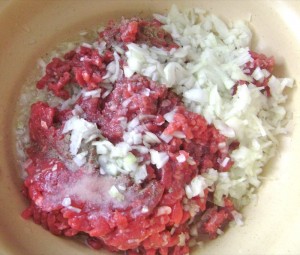
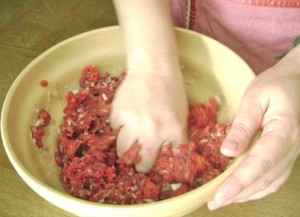
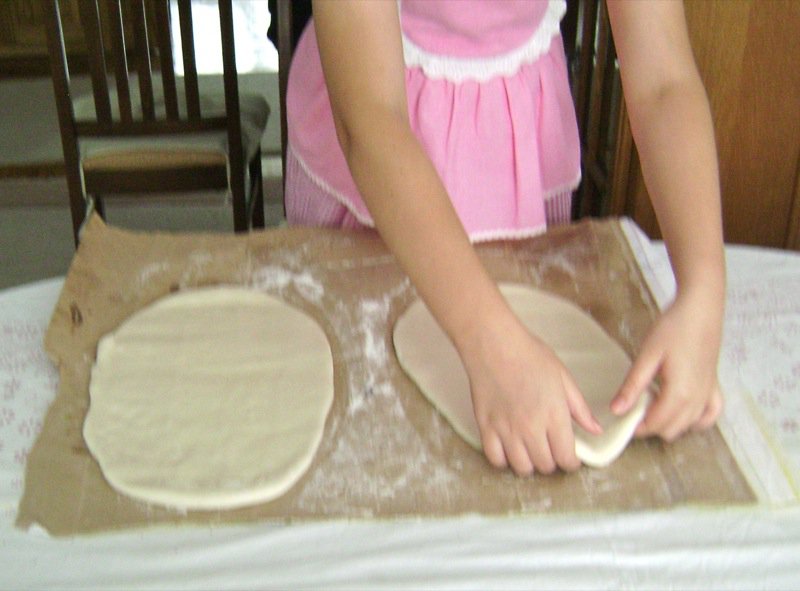
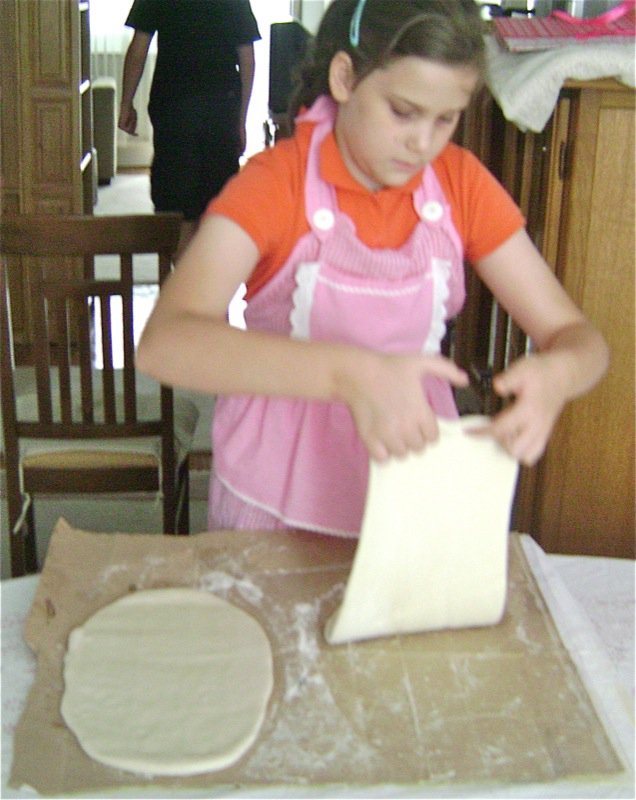
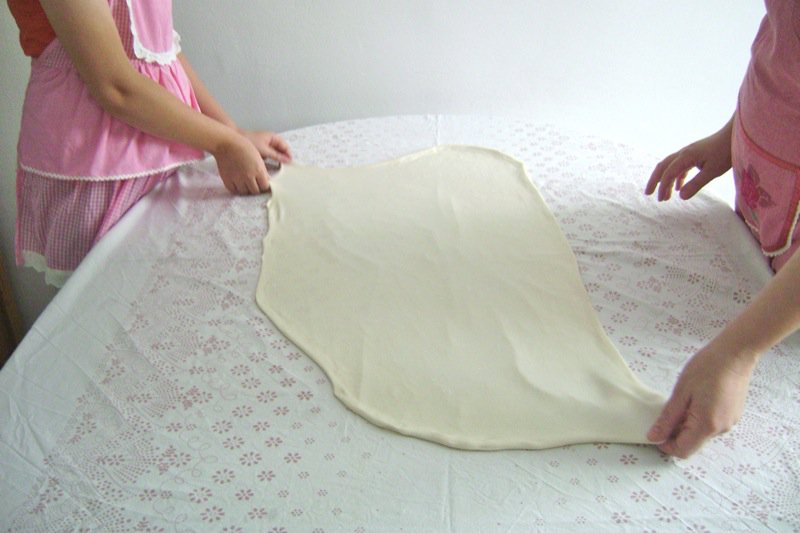
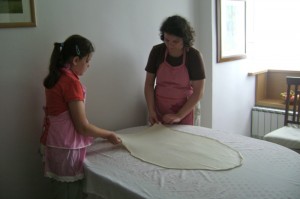
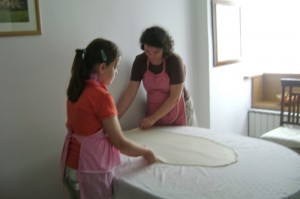
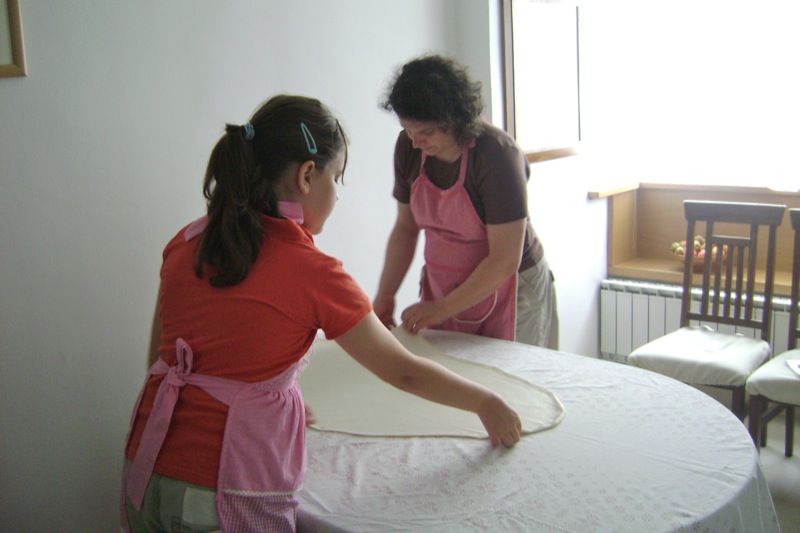
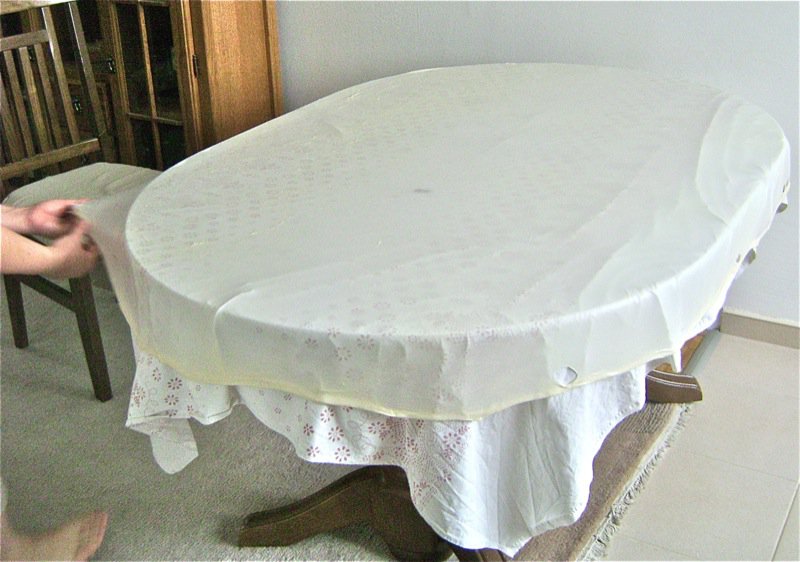
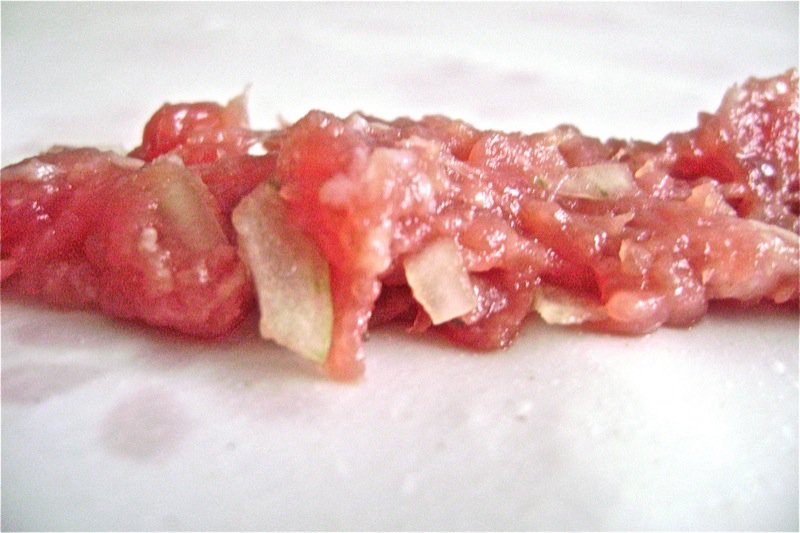
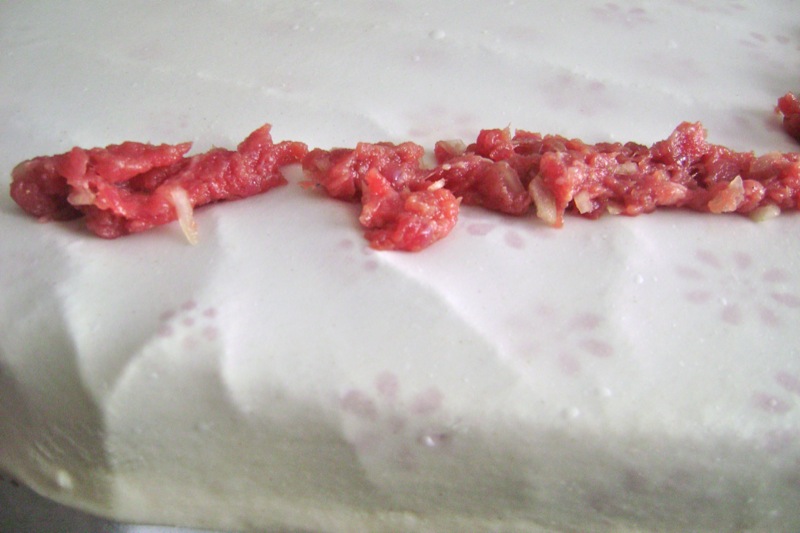
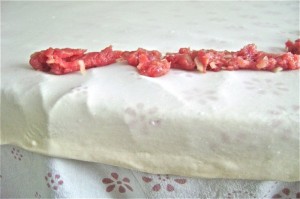
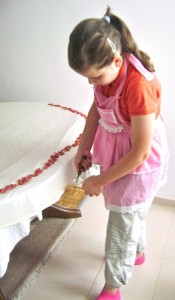
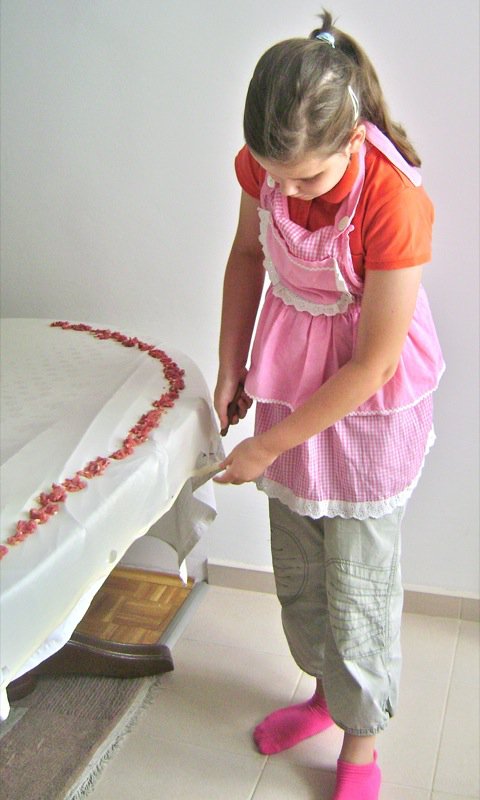
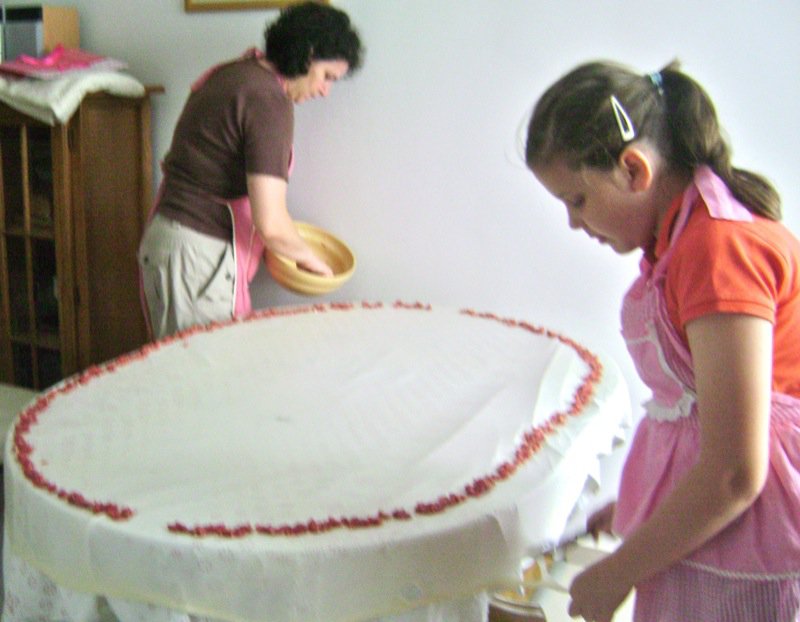
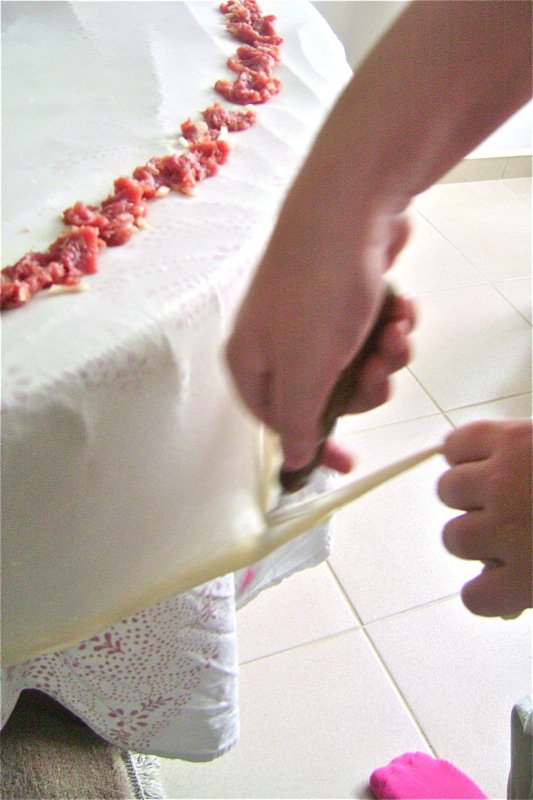
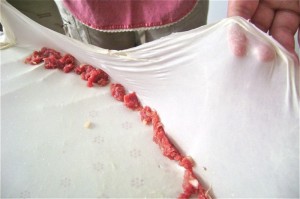
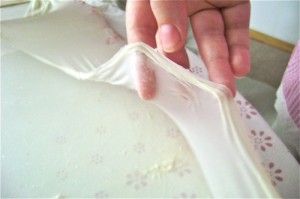
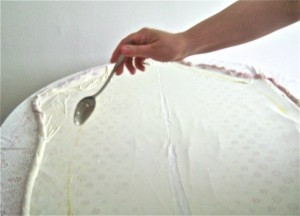
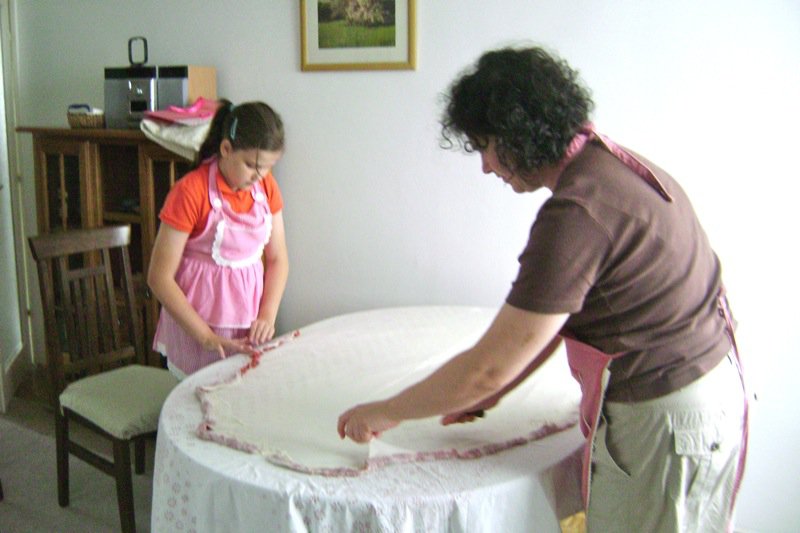
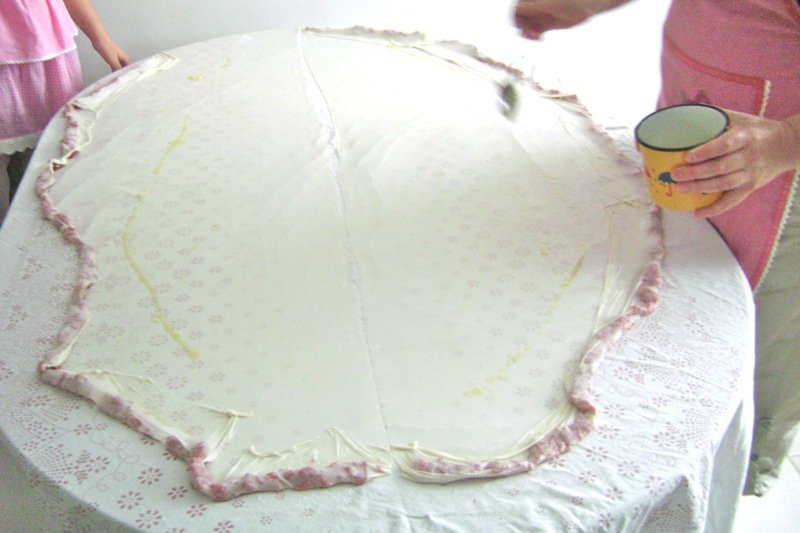
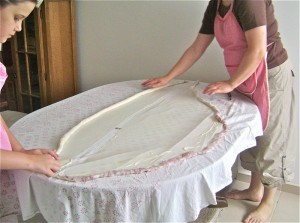
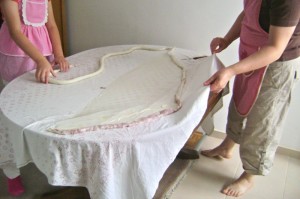
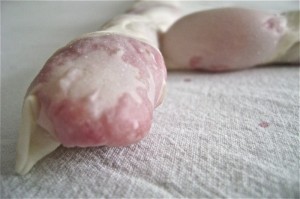
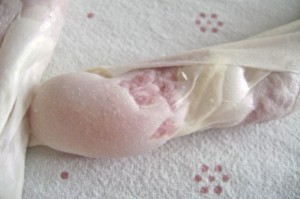
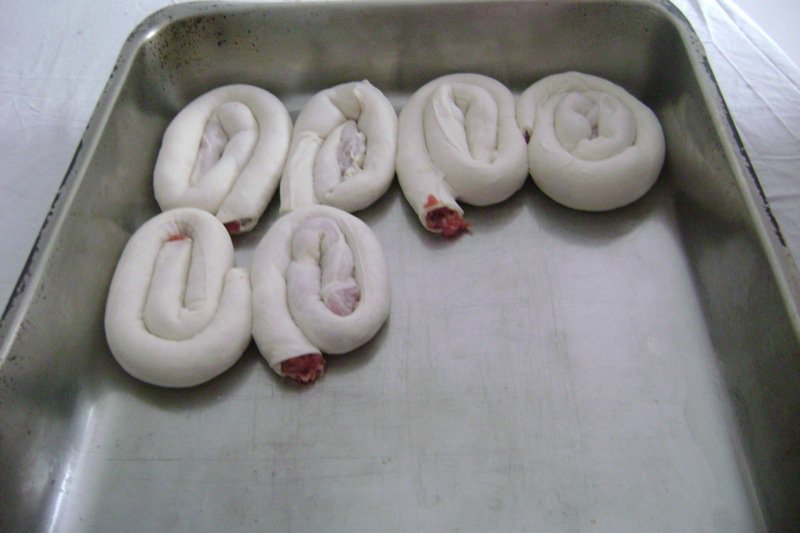
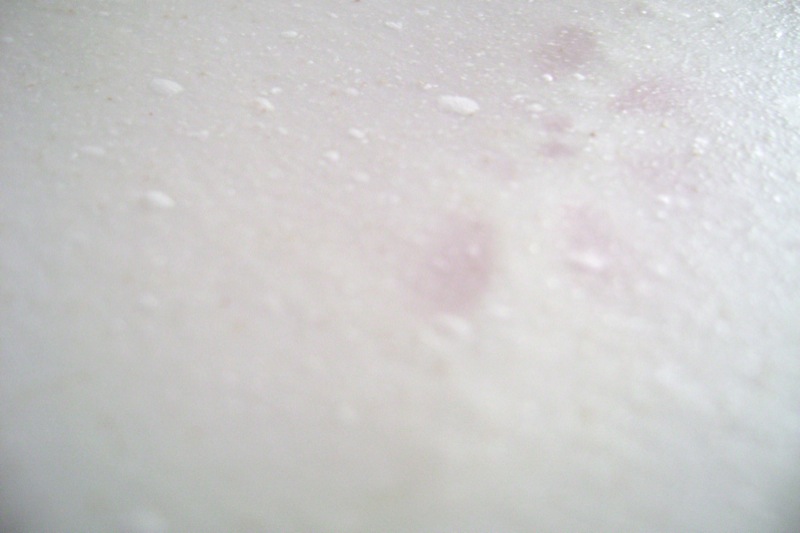
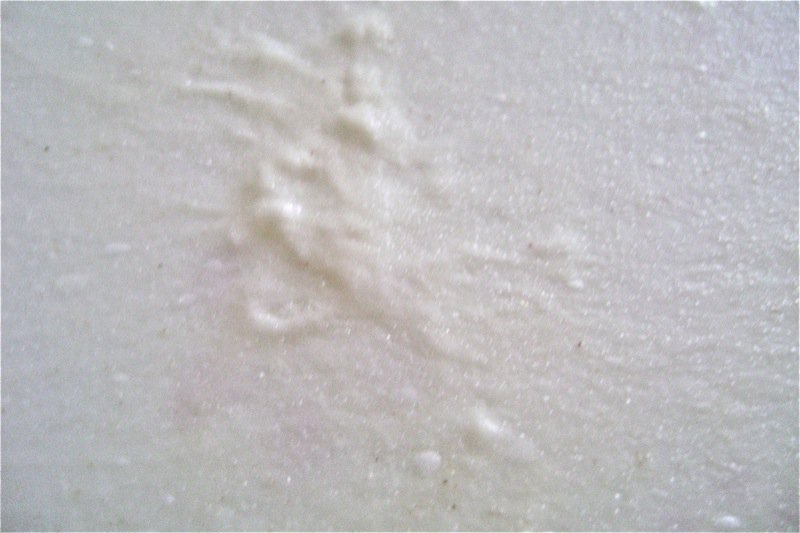
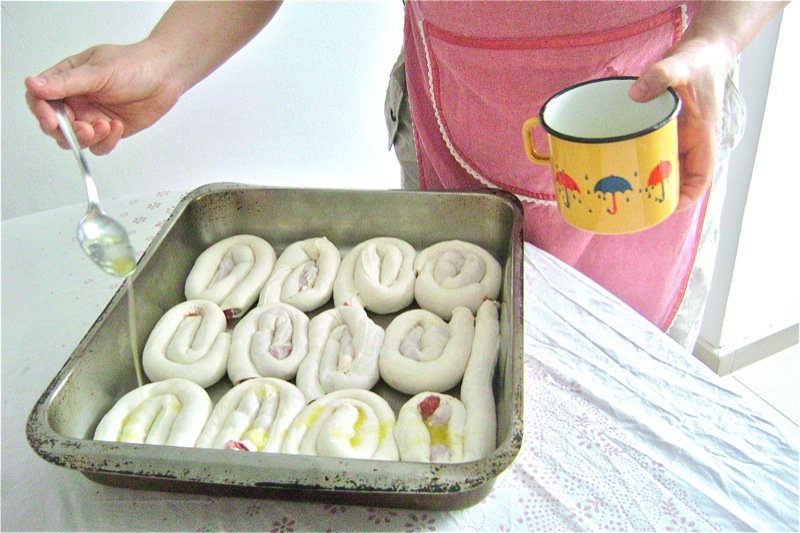
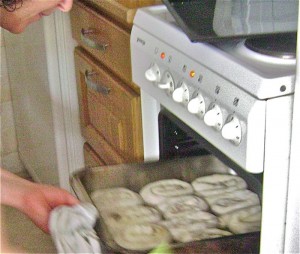
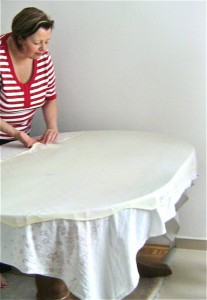
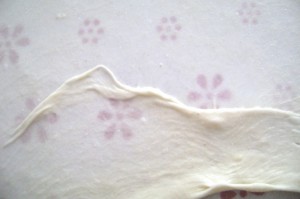
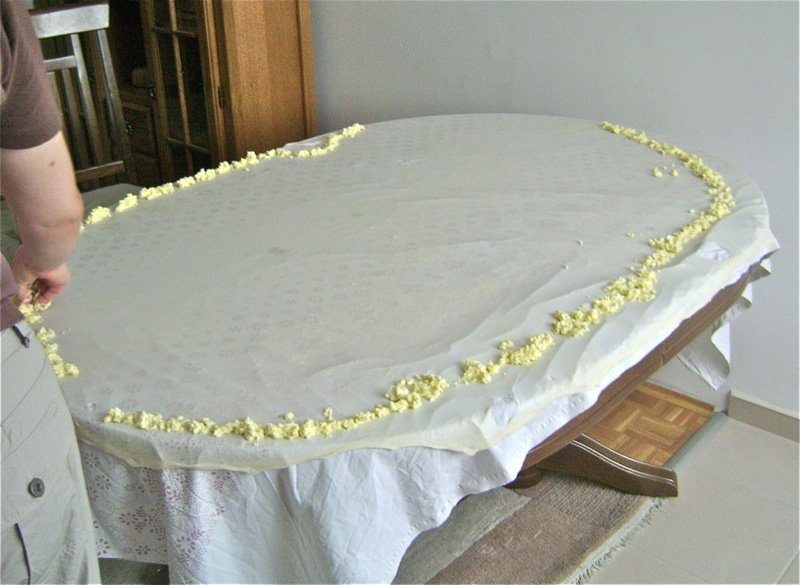
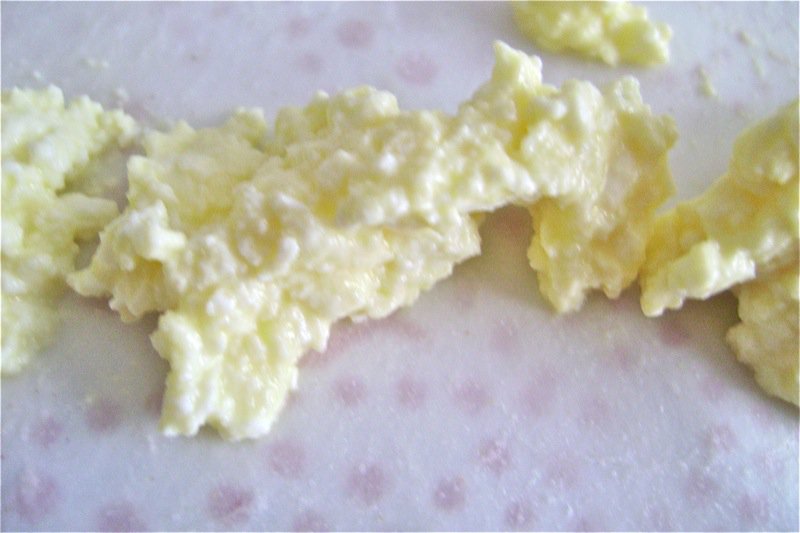
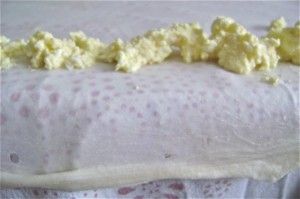
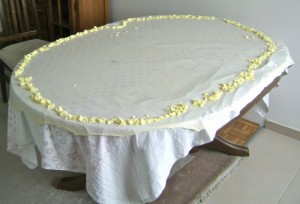
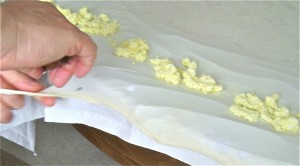
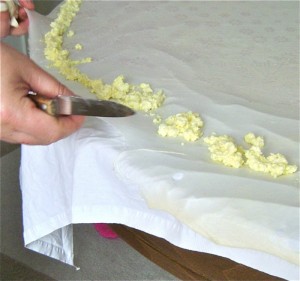
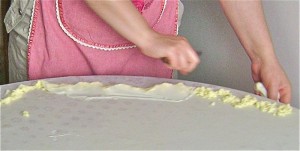
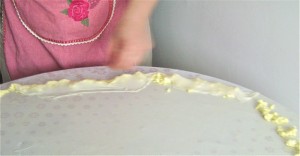
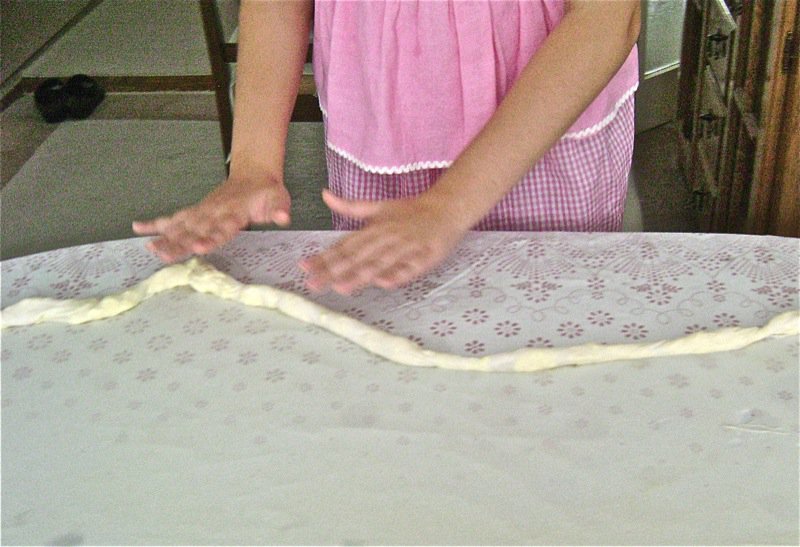
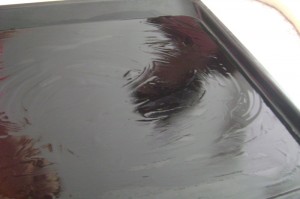
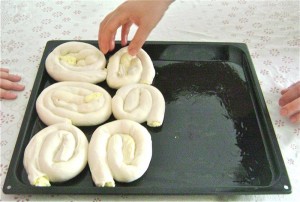
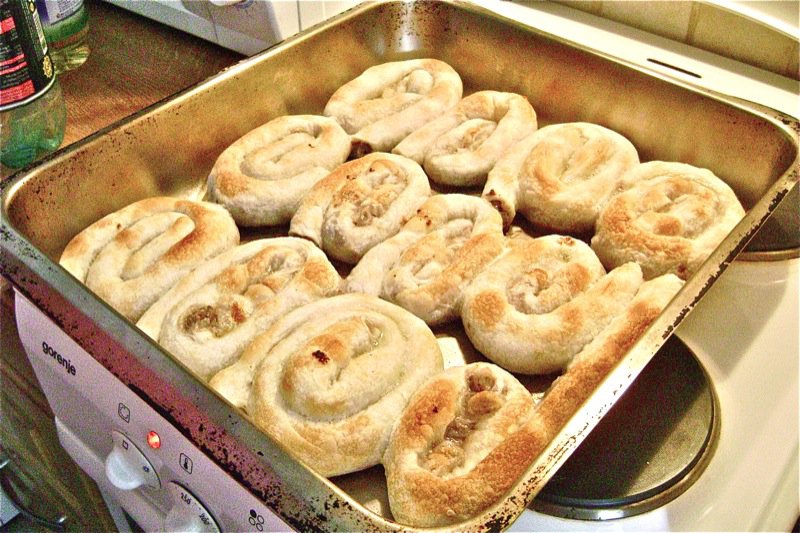
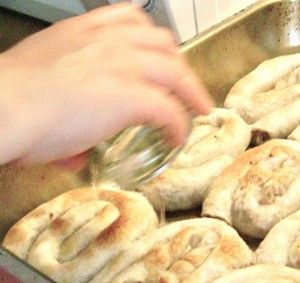
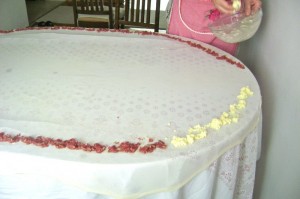
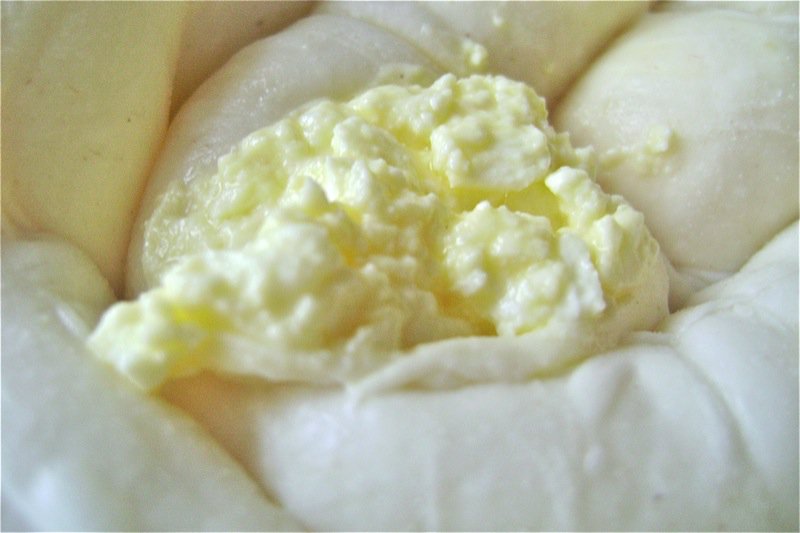
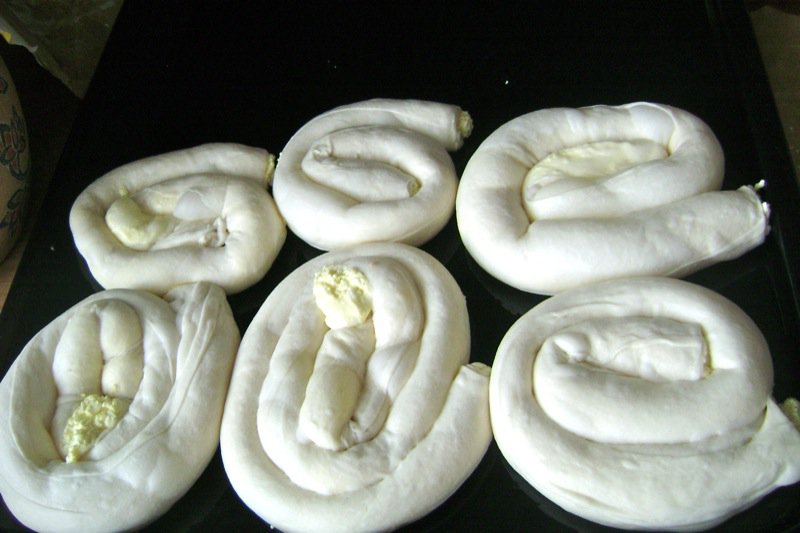
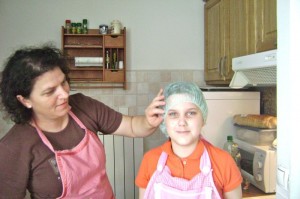
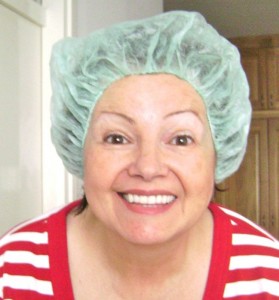
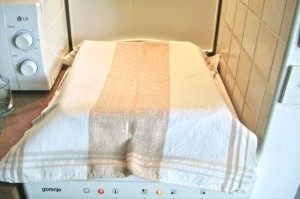
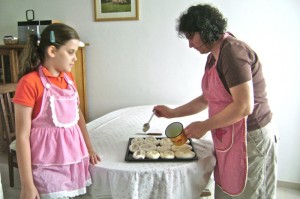
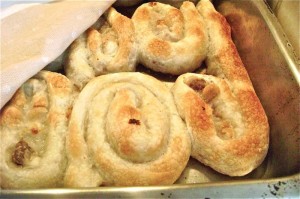
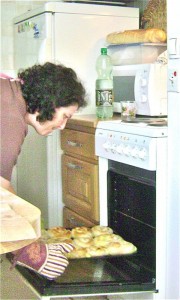
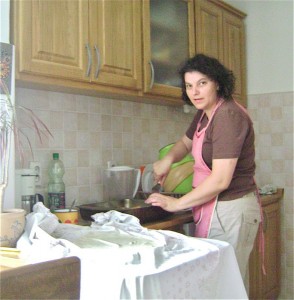
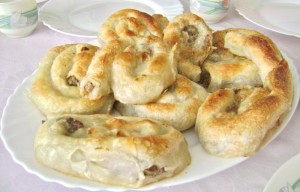
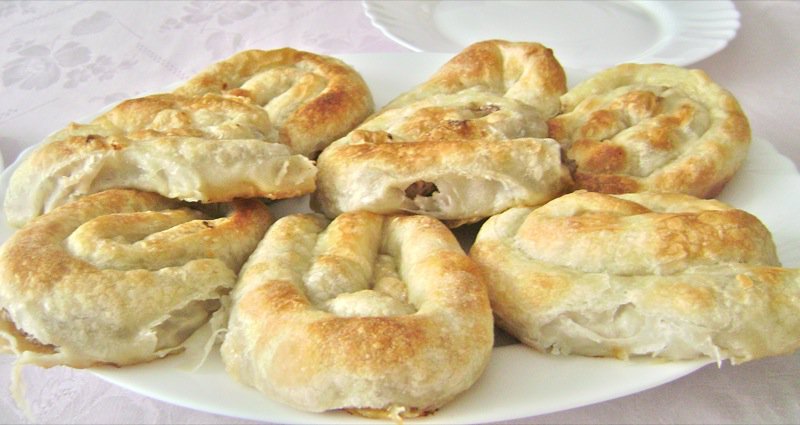
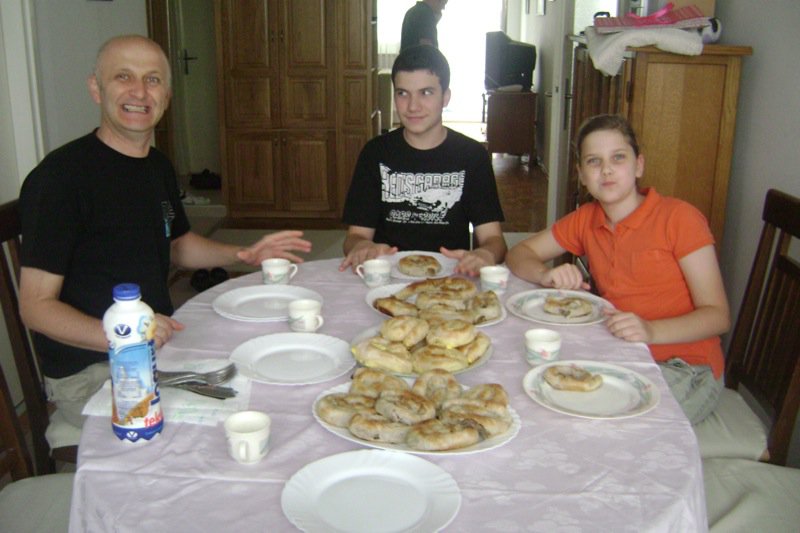
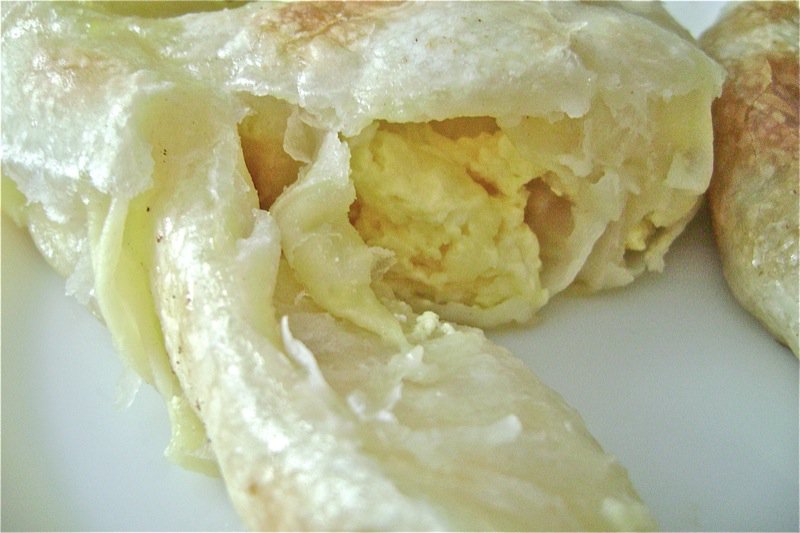
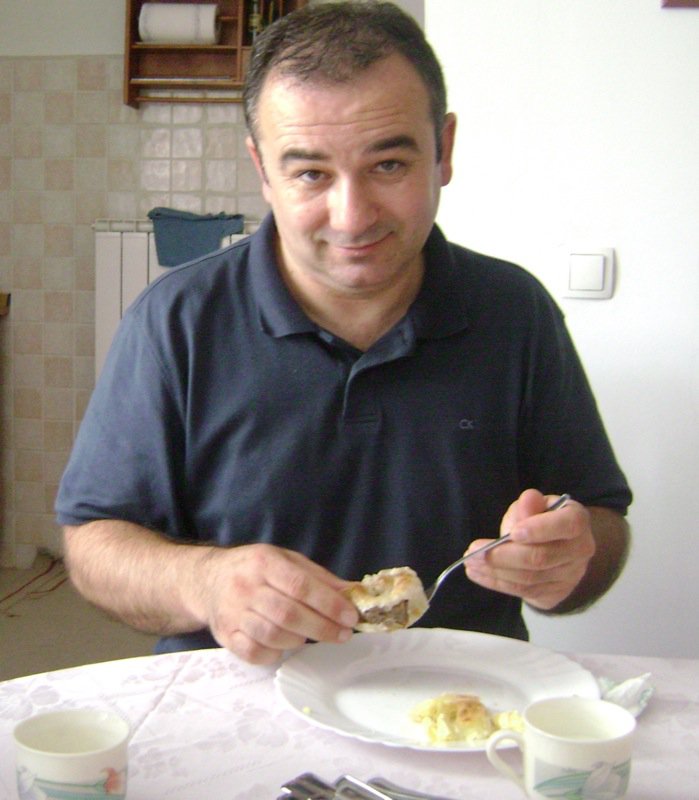
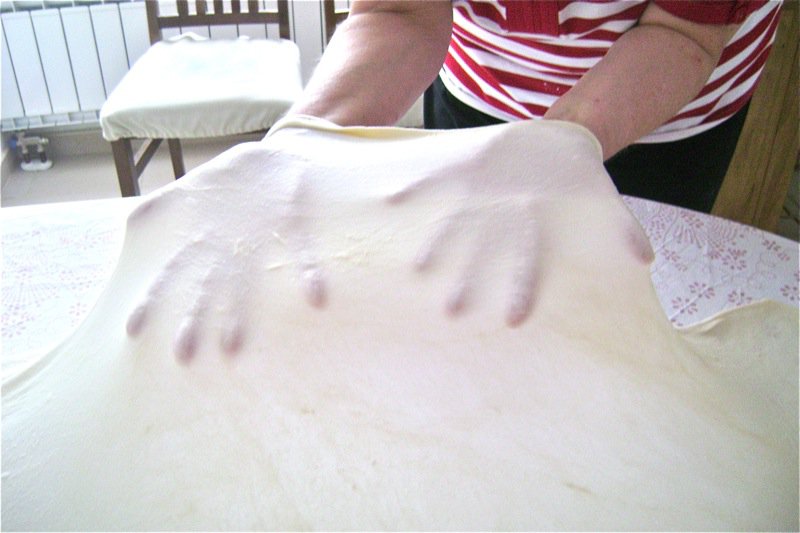
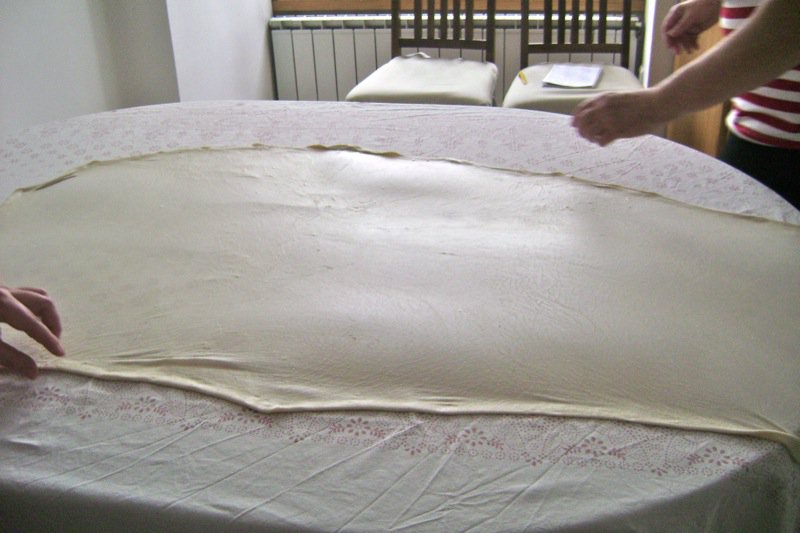
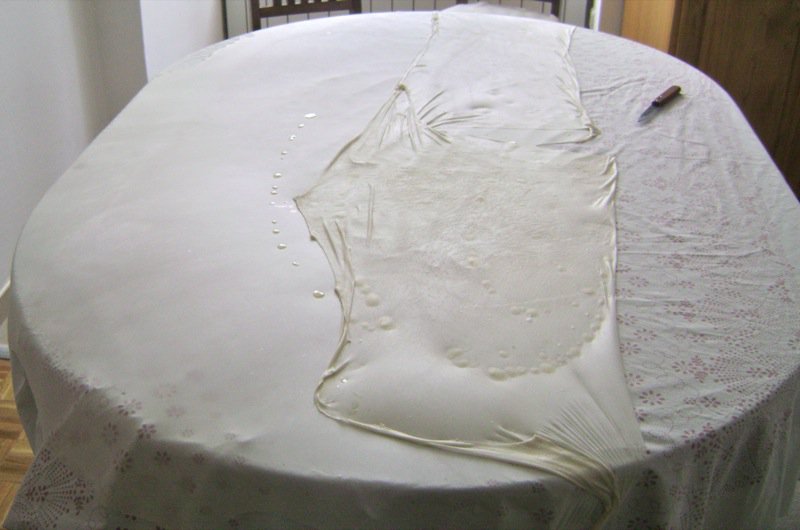
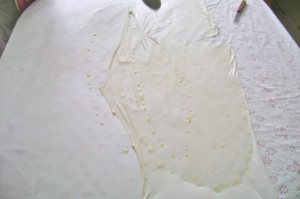
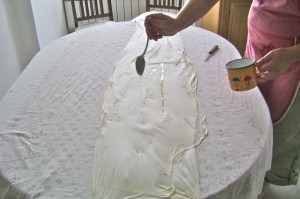
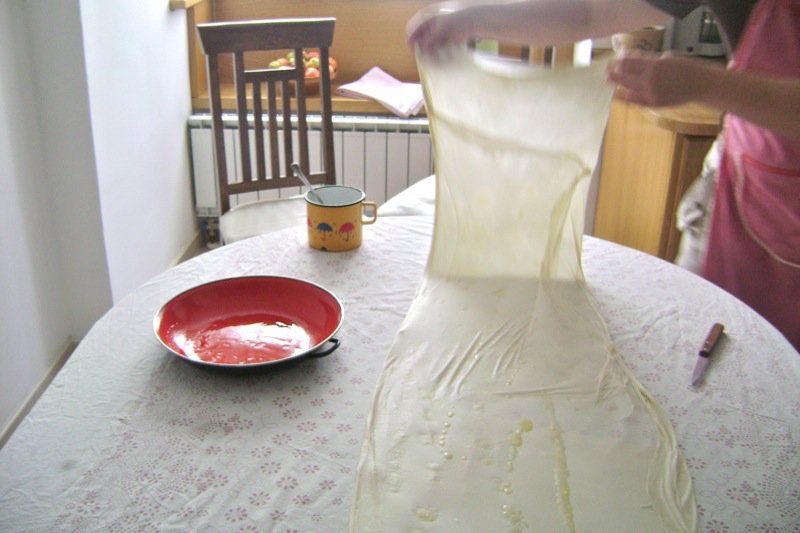
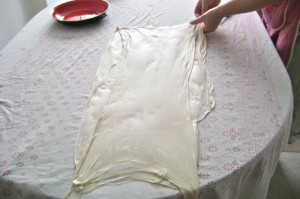
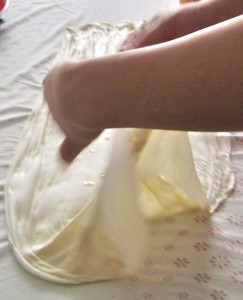
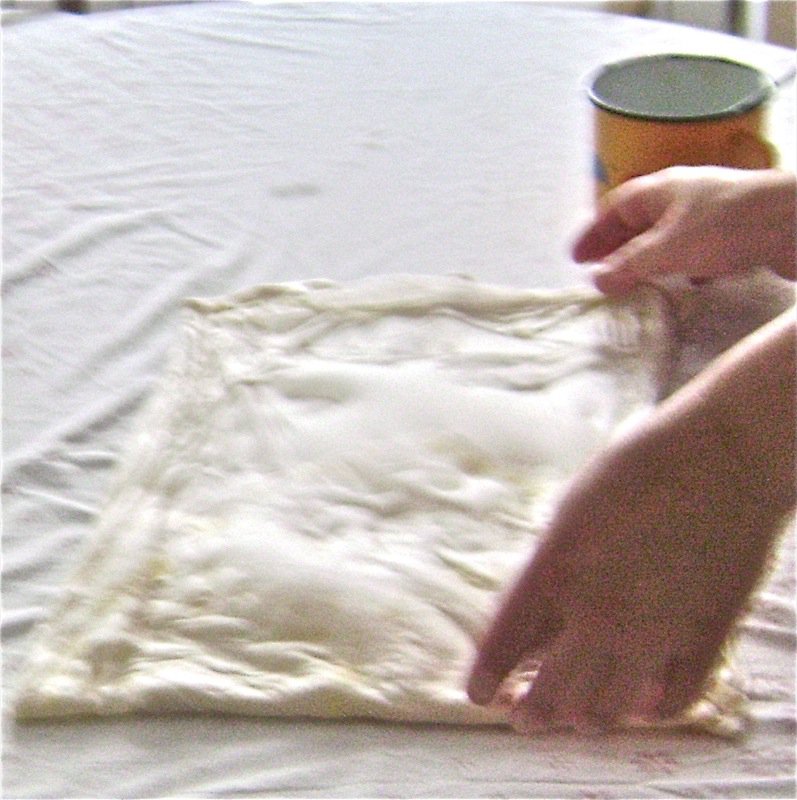
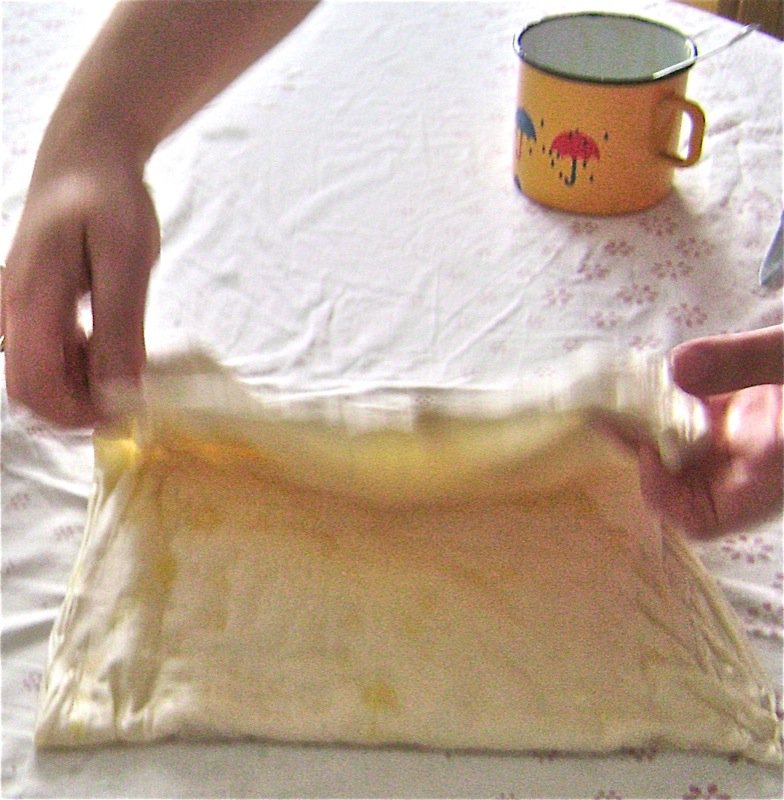
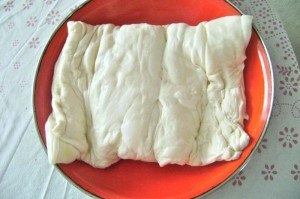
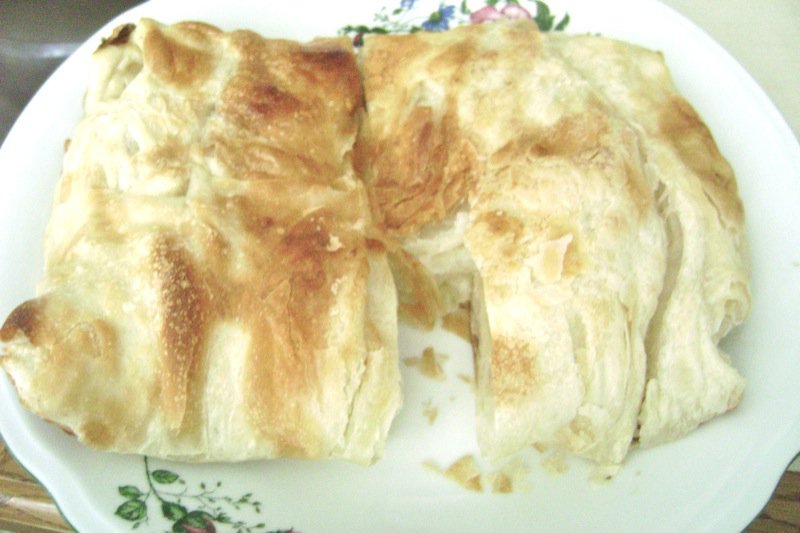
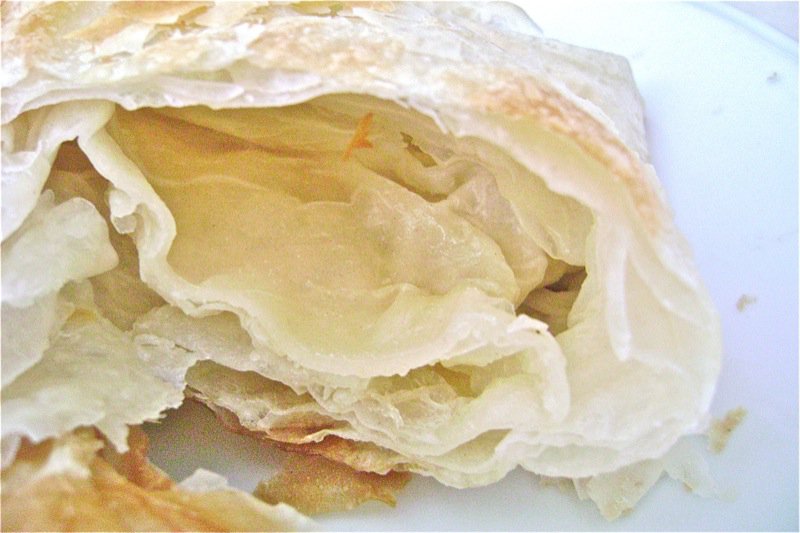
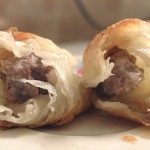
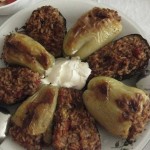
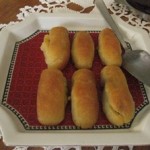

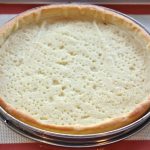
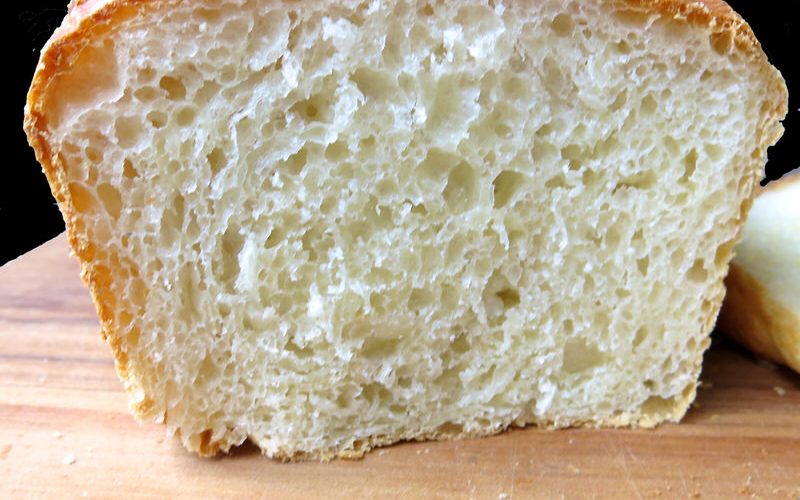



Wow Val – I am impressed at the lengths you go to to give your hubby an authentic meal! Plus that little girl is gorgeous – you can just tell she is enjoying herself cooking and smiling for the camera.
That dish is SOOO OOOOOO cool. If you ever nail this, please invite me over to try it?!?!
And yes, that beef looks lovely. Rather like Shannon and Danny’s at Nature’s Green Acres. 😉
That is such a great post! I would love to try making this, as it all looks and sounds so delicious. I loved learning from my grandmother and have such happy kitchen memories. It looks like Emina will too.
Wonderful post. What an interesting process to produce the dish. Love the joy in that little girl for what she’s doing. A future top chef for sure.
excellent post, what a talented little lady…how wonderful for her to learn her heritage, The entire process of this wonderful treats is just spectacular, I am seriously tempted by the sir pita.
sweetlife
wow Valerie, you always manage to find such wonderful recipes and family traditions to learn. always, the eager beaver aren’t you? speaking of which, where has the little fella been? anyways, you are hilarious! i can totally see the “adult kindergarten you” waiting for her turn at the water fountain. that is the side of you that i love so much. never lose that hunger to learn, my friend 😉
i am still in awe of how thin the pastry was able to stretch. thank you for showing me how burek and sir pita are made and for teaching me what they actually are. i would love to have tried the sir pita and the left over pieces of plain pastry (i’m not much of a meat fan). what a priceless lesson indeed. hope you are as successful in your attempt.
“œWhen a woman is able to make this dough perfectly, she is ready for marriage.”
OMG, someone please get that lovely little girl out of the kitchen LOL!!!
I’ve seen dough like that being made on a tv show once, where it is stretched across the table. How fabulous to see it done in person! I adore burek, though i think the version i’ve had is a more middle eastern style, shaped like a triangle and filled with spinach and cheese.
Wonderful post!
*kisses* HH
Awesome post with many new things for me to learn. The photos are great too. Thanks for sharing.
It’s always a pleasure to watch homemade phyllo being made. I’ve seen my mom do it and I’m still in awe. Bravo!
This really is quite the process. I would say that my mom missed the cooking gene and yet I remember her making strudel dough like a pro. These burek and Sir Pitas are on my bucket list to try.
Wow Val ““ You NEVER EVER cease to impress me. I don’t think I have EVER seen a piece of dough rolled out the size of a table – a table!!!
You are so cool and if it weren’t for Vanja and you I’d be missing out on loads of culinary education from around the world.
Love it! The little girl is gorgeous and so enjoying herself cooking and smiling.
Ciao, Devaki @ weavethousandflavors
This is so cool! A Turkish friend of mine used to make burek for us, I love it!
Wow! I’m impressed. Bread and any kind of pastry has always flummoxed me.
Do you know about the Raincoast cookbook contest? They have a cool video posted about Tartine Bread.
http://www.raincoast.com/contest
Cheers!
Monique
Wow! Very brave! I can’t believe the size of that rolled out phyllo dough! I think the cheese one is my fave!
I’ve never ever seen dough rolled out to that size. Takes a lot of skill but the end result looks delicious and hubby looks pretty happy.
I have always been told that to get to a man’s heart you go through his tummy and he’ll be a content Hubby for sure. However, hats off to you Valerie because I sure wouldn’t even come close to this whole adventurous procedure. I sure hope your Hubby realizes what a gem you really are!!!
Flavourful wishes,
Claudia
Val,
This is probably the best blog post I have seen (not just yours, but all of ’em). I love it and need to try making it. The table sized dough though sounds a little scary….
Wow, Valerie – that is amazing! I cannot believe that dough technique. It is so thin, I bet that is a workout. You are too cute in your red & white stripes.
I need to start wearing glasses when I cut onions like Emina. She is a cutie. Lucky her to learn so much, she will offer loads to the world. I bet this food was amazing-especially because you had so much to do with the preparation. xo
This whole process is quite mesmerising. What an experience, and just perfect to get the whole family or a group of friends involved in.
I love the use of the bag to roll the flour on too. It’s so fabulously low-fi and seems to work perfectly.
OH MY GOD…this entry is amazing! First off, I bow to you for making phyllo from scratch! I can’t even roll out a pie dough without holes that need to be patched, and I’d be mortified showing you my strudel dough from a past DB challenge LOL.
The time, effort and love you put into the Burek is just beyond amazing, and it shows in the final, beautiful,flaky to the hundredth degree, pastry. Your hubby looks like one happy man! Fantastic photos, so fun to scroll through. I wish I had even a modicum of natural light in my kitchen! This is why you rarely see step by step photos from me *sigh*. Regardless, what a fun and amazing day you had, and thank you for sharing it with us! xoxox
Wow, I loved seeing the process of making this authentic dish! You captured it so wonderfully with your step by step photos! I especially loved to see how the dough was stretched out!
Oh, Valerie, this post is stunning! The way you open up whole new culinary worlds for us, teach us every detail with such loving care, and make us feel that we are right there along side you is just too wonderful for words. I so want to taste the fabulous dishes you’ve made above. But darling little Elsada, with her calm confidence and mastery of these dishes, makes me feel inadequate. I’m not sure I’ve got what it takes to “be a good Balkan wife.”
These look awesome!, gloria
Oh my goodness, Valerie – I am so impressed! What an undertaking to make the burek especially! The dough is so thin!! I can see how it would require a lot of skill … and a lot of patience!
Emina looks like a lovely little lady – and I love the shades! The picture of you with the cap is a keeper 🙂 I wish I could be at your table!
Wow. What an incredible amount of work. You did a great job with this recipe. Nice that you had such a wonderful team. Amazing! BTW- it was a regular cupcake pan with Wilton cupcae wrappers. They’re new and a bit taller on the sides.
Thank you, El! That is amazing as your chocolate cupcakes have a unique shape that I love. I will definitely keep my eye out for such a pan – though I rarely make cupcakes…but, maybe more now, as your ganache frosting was perfect!
🙂
Valerie
What an amazing experience to learn from authentic cooks such as this, I so envy you for this experience Val. I’ve certainly made phyllo before but nothing like this. Big Wow factor, thanks for sharing.
Anna: You’ve made phyllo before! WOW! But you made it differently that this? You have caught my attention! I can’t find it on your site. Can you post the link here? I would LOVE to see how you did it!
🙂
Valerie
I am totally fascinated with the burek dough!!! For the filling, I think I will have to use German Quark instead. Emina has talent of cooking!
I bought a Balkan cookbook long time ago and it still sits somewhere on my bookshelf…;-) Now I am going to get the book out and study a bit…:-))
That looks delicious! There seems to be a lot of work to do, but I think that every minute deserves to be investet in such a great creation.
The dough looks simply amazing! One of my coworkers has given me homemade burek a few times, and described the process of how to make it, but I could never really picture it – thanks for sharing!
Wow, what a lot of work to make this delicious looking meal! It definitely looks like you girls had a lot of fun making it! It sure looks incredibly good, but I am not sure I would have the patience to make it myself…! 🙂
Wow, Valerie! I can’t believe how Elsada and Emina were able to get the dough so nicely across the table. So talented…
Oh, and I love North African burek that is not even homemade, so I can’t imagine how crazy I would be for that cheese pastry. Yum. I really admire your determination towards all things culinary, Valerie;)
Ooh, and Happy Halloween!
Wow is all I can say about this. My respect for you has just tripled for taking on such a laborious task. AMAZING dough as well as filling.
xo
Nisrine
Loved reading this post. Beyond my abilities (for now!) but they really do look and sound wonderful. I look forward to checking out your site some more!
This past couple of days I have been attempting burek, Armenian-style; then I stumbled on your post (checking my RSS feed too late!) and see this!
What an amazing documentary; I could see this whole episode being filmed! I love it! I need to find a similar flour and try this at some point. Your husband is so lucky that you take an interest and make the effort to adopt his cultural traditions; I had to chuckle when you wrote ” is it legal” (re: selling milk and cheese from the farm); if it is anything like Lebanon, nobody cares if it is “legal” or not.
Thank you for a great post which I will bookmark for future reference.
Joumana!
I cannot wait to read about your Armenian burek when you make it! How is it different. The pastry must be the same? And, you are right! No one does care if it is legal or not!
🙂
Valerie
finally the real deal! i have scoured the net to find anything that looks remotely like what the lady we used to live net dor to in Germany made…we were in a very internationa community. this is EXACTLY how we made it and my daughter who was 7 a t the time used to go over to help.
THANK YOU THANK YOU THANK YOU.
My dough is excellent however at times it pops open & my cheese spills out is my dough to thin or do I fill it to much
Lucy,
Look at the photos, the cheese cannot pop out if you roll it and fill it as done in the photos: sparse filling and rolled with layers and layers of dough. Hope this helps.
🙂
valerie
Kajmak is kaymak in my language and it is thick cream of milk, I want to thank you for your effort to show us these much info with nice and step by step pictures.
1 kilo flour
2 teaspoons salt
340g (400ml) water
1/4 cup melted unsalted butter
1 tablespoon oil
Hi, there seems to be some inconsistencies here concerning the water content or the weighing translations.
340 grams of water equals to 3,4 dl not 4,0 dl(400 ml).
400 ml water is far too little for 1 kilo flour which equals 2,2 pounds.
Yo HAVE to add extra water, at least 2 dl for 1 kilo flour.
I think the correct measurements were lost in translation.
From Turkish to Canadian (, american) and then European.
I have followed this recipe 7 times now and it all works out provided you do guesswork on the measurements of the ingredients (as is a very common feature of recipes on the net) due to the fact that most cultures have their own measures for weight and volume.
1 gram of water is always 1 ml. 1 liter water is always 1 kilo.
May I suggest that you either use cups/pounds/gallons or the metric system being grams, kilograms and liters and look over the measures.
The flour amount cant be right either.
340g (400ml) water is totally wrong.
It should read:
340g (340ml) or 400g (400ml) which is too little by at least 200 ml
Its the only thing that ruins this recipe.
Thanks to this blog I finally managed to get the burek dough right. Its thinner than pages in a bible. It behaves just as on the pics. This is sofar the best recipe I have found in spite of the abovementioned faults.
So, please, check the measurements again to the Turkish original and correct what you can. Then this blog will really mean a difference, which I think was the intent from the beginning.
Conversion site:
http://www.convertunits.com/from/cup+%5BUS%5D/to/deciliter
Regards,
A.
Thanks, Adam
There was NO Turkish translation.
I was in the room, making this recipe, in ENGLISH, with the Bosnian woman carefully explaining the proportions to me – and she has her masters in Chemical Engineering, so is a master at measurement and conversions. This is exactly the amount used at her house in Tuzla. The elevation, flour, climate, etc. will make a difference to where you are. She has also checked the recipe after I wrote it to ensure that all of the information was accurate. But, thank you for sharing what works for you, where you live.
🙂
V
…masters in Chemical Engineering, so is a master at measurement and conversions…
I dont think so…
Not even a masters can make 400 ml water out of 340 grams of water.
Thats the point. Its impossible.
Only then in Bosnia does 340 grams of water equal to 400 ml water by some
unexplained anomaly of physics yet to discover.
That 1 gram of water measures 1 ml is elementary school Grade 8.
Lets leave this discussion.
Too little water in the dough from the start is a disaster, thats why I bother. This blog is still the best, except for some misunderstanding of
the weight/volume ratio of water.
Sorry, I meant Bosnian not Turkish.
Regards,
A.
can you send me a reicpe for burek please
Valbona
If you do a search for burek on my site, there is another post with a complete recipe in it. The link to it is actually in this post.
🙂
Valerie
This is a lovely story! I am half Slovenian American and remember watching my grandmother stretch out strudel dough. So this brings back memories. I do make potica, but haven’t yet had the nerve to make strudel with homemade dough. Gearing up for that, though, as I am in the midst of a year long Slovenian cooking challenge, cooking and blogging about it. You are an inspiration!
Great recipe thank you! My husband is from Tuzla, we live in Australia…I love the food when we go there for a visit, everything tastes so amazing and fresh!! I haven’t attempted to make the dough myself..I think I’ll wait to we go visit next time and get his mum and grandmother to give me a lesson. Hvala puno!
Tanya!
What a small world! Our husbands may know one another! For sure they will know some of the same people. My husband lived in Lukavac for most of his life, which is very nearby. One of our best friend’s brother is also in Australia in Adellaide. He is also from Tuzla. Vladan is his name… and yes, I know Australia is huge and you may be from the other side! But, it is still a SMALL world!
🙂
V
Hi Valery
I have dear friend from Bosnia they come from Tuzla also. I am not of European decent but I learn to love the Bosnian Food. And I had the privilege to see also pita made from scratch many time. They do are really proud of “showing off” their skills. And I have yet to meet more welcoming, heart-warming people and so generous!
I was invited many time to come and visit Tuzla but couldn’ t.. I hope that, God Willing, I will be able to spend time there some day.
Thank you for the explanation because some hints did escape me while watching them make pita, and moreover it’s been more than 10 years.
Thank you reviving some of those tender memories!
P.S. Do you but butter into the dough?
Hi, Rehana
Wonderful to meet you! No butter into the dough, but a little on it. You can see it being swirled or splattered sparsely from a cup.
🙂
V
I have been searching for a delicious burek recipes with the right explanation for months! And I found this! I can’t wait to make this food for my family! Thank you! Please post what other fillings you can use with this dough. It reminded me of the street food in turkey, but yours is way classier! I can serve it in parties!
First, let me tell you, I made this maybe a year or so ago and it was awesome! About ten years ago, my sister lived next to an Arabic woman who would bring her over the most amazing food, which she would share with me (we both wish we kept in contact with her!). I searched high and low for this unfamiliar dough/meat recipe, to learn that it is Borek. I tried this recipe and we were both wowed over at the taste and likeness of the old neighbors food. Unfortunately, my computer was destroyed along with the bookmarked page. I’d since forgotten the name and I’ve been searching for the last hour trying to remember the name of this recipe – using Arabic, Lebanese, Iranian, Turkish, recipe, you name it – in the search engine!!! Alas! I have found it and am pinning it so I will never lose it again. I may just print it too. Thank you sooo much for sharing your story and your recipe. I look forward to cooking this again.
Hi Valerie,
I just finished reading your well-instructed recipe and just printed a copy to take home after work. I plan to make Burek and Sir Pita on the weekend to surprise my husband. He is from Tuzla and I am from Philippines. I guess he will adore me more if I manage to make him some of these wonderful pie originated in the Balkans. Specially if I serve it for Iftar (dinner served after fasting during Ramadan (Fasting Month for Muslim) which translates to Breakfast for us who fast). Personally, I cannot wait. Just because I am not a cook at all. I knew basics and hoping your site could help me learn more. Because I too would like to be a Good Balkan Wife 😉
Thank you so much and all the best. Keep posting recipe like this and please direct me to your website where I could learn more.
Maria
Hi, Maria
If you sign up for my weekly newsletter you will get all of my new posts in your mailbox every Saturday morning. Let me know how it turns out!
Valerie